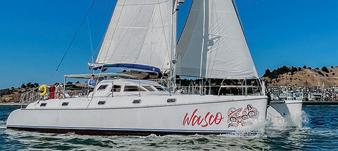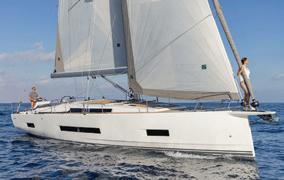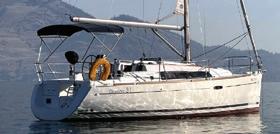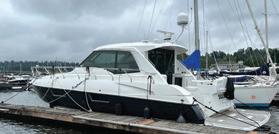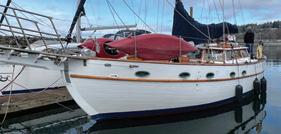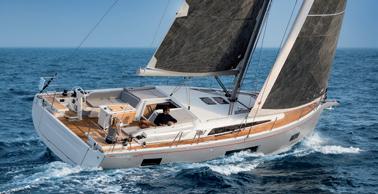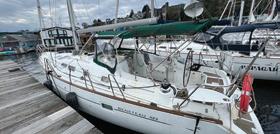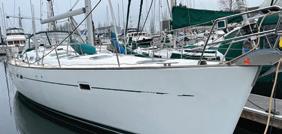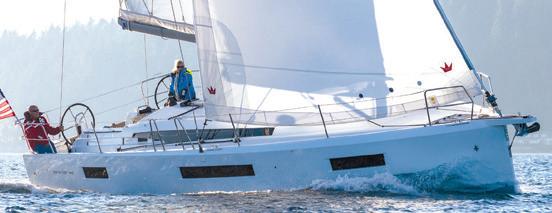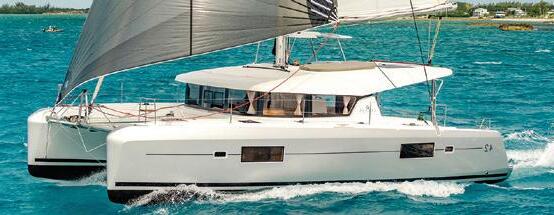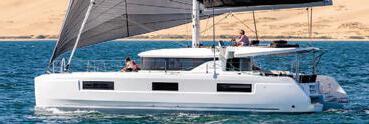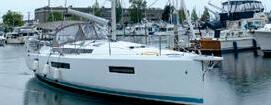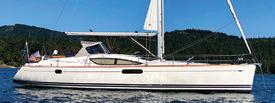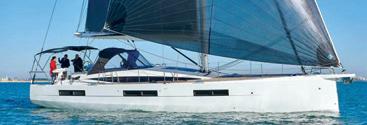








































Velocity. Trimmers feel an increase first…before the numbers confirm. Using sheet as speed barometer, they’re also the first to know when pressure softens. And they respond. The 7 ceramic ball bearings in a new Zircon block overcome inertia from friction so easily, information flows acutely through the sheet. Simply put, trimmers feel and better match sail shape to the new condition–often the difference between winning and not. At top wind ranges, you need more purchase to trim harder. Go for it. When the breeze backs off, Zircon blocks let you ease… even through all those sheaves.

 Andy Cross
By Meredith Anderson
By Marty McOmber
By David Casey
By Lisa Mighetto
Andy Cross
By Meredith Anderson
By Marty McOmber
By David Casey
By Lisa Mighetto
Cruising means something a little different to everyone. There are as many unique definitions as there are cruisers out chasing their dreams. Thankfully, the waters of the Pacific Northwest accommodate pretty much any cruising incentive.
I can recall my first experiences at some of the Salish Sea’s most famous and wellloved cruising gems, the heavy-hitter short-list of can’t-miss destinations. Each offered ample wonder and was entirely new to me. Each quickly revealed why they sit atop the PNW cruising-stop pyramid, drawing boaters back year after year with incredible beauty and rich shoreside attractions, natural or otherwise. Also, each offered crowds of breathtaking scale, for cruising anyway — snug anchorages, only a faint hope of dock space or mooring buoy availability, well worn paths ashore, and an inevitable community-living experience. Were those visits fun? Will I go again? Did I learn something about what motivates me as a cruiser? Heck yes, all around.
For me, and for the cruisers whose approaches resonate most with me, there's a desire to get off the beaten path, even in my home waters. In this age when information is so readily available, it can feel like there’s nothing left to discover. Still, I’ve found that it takes only a small effort to find your way to a much more remote version of cruising.
At the risk of a tantrum about algorithm-driven content, my impression on and off the water is that the ways we access information today tend to lead large percentages of folks to small percentages of the destinations. This has always been somewhat true with cruising guides, but I think the recommendations become more distilled through modern vehicles — in part because it is so much easier to happen upon the same suggestions that your dock mates have also seen (sometimes by design), and because authoritative-seeming resources can make you think you’ve tapped into curated expertise without needing to delve any deeper. These resources have value and serve their purpose. Importantly, though, they come with an encouraging reassurance: as some resources funnel throngs toward certain locations, alternative options are nearby and innumerable. Cruising guides are actually excellent resources to help you find these unsung alternatives.
Keep an eye out for situations when conventions and best practices limit awesome possibilities. There’s an obvious example in this issue (page 30), in which Washingtonbased cruisers decide to sail back from Alaska by foregoing the typical Inside Passage route. Yet, it need not be such a major adventure to capture this spirit. Think about “situationally great” anchorages. Truly ideal anchorages will have terrific protection if a storm comes from nearly any direction. However, some of my favorite nights on the hook have been in places where we go to sleep knowing that if some unforecast breeze comes in from the wrong direction, we will probably have to move. It’s tough for these places to make the top-ten lists, because they aren’t right for most folks in most situations. Nevertheless, they were magical to me.
Pacific Northwest boaters’ access to a range of cruising experiences is second to none — including some spots so remote and extraordinarily beautiful you’ll wonder why people aren’t there in droves. Happily, opportunities abound on our waters for cruisers seeking the course less traveled.
I’ll see you on the water Joe Cline, Managing Editor, 48° North

Volume XLII, Number 10, May 2023 (206) 789-7350 info@48north.com | www.48north.com
Publisher Northwest Maritime Center
Managing Editor Joe Cline joe@48north.com
Editor Andy Cross andy@48north.com
Designer Rainier Powers rainier@48north.com
Advertising Sales Kachele Yelaca kachele@48north.com
Classifieds classads48@48north.com
Photographer Jan Anderson
48° North is published as a project of the Northwest Maritime Center in Port Townsend, WA – a 501(c)3 non-profit organization whose mission is to engage and educate people of all generations in traditional and contemporary maritime life, in a spirit of adventure and discovery.
Northwest Maritime Center: 431 Water St, Port Townsend, WA 98368 (360) 385-3628
48° North encourages letters, photographs, manuscripts, burgees, and bribes. Emailed manuscripts and high quality digital images are best!
We are not responsible for unsolicited materials. Articles express the author’s thoughts and may not reflect the opinions of the magazine. Reprinting in whole or part is expressly forbidden except by permission from the editor.
SUBSCRIPTION OPTIONS FOR 2023! $39/Year For The Magazine $75/Year For Premium (perks!) www.48north.com/subscribe for details.
Prices vary for international or first class.
Proud members:



THE PARTIES ARE BACK!















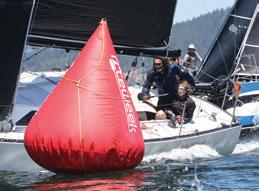

"Race
in Anacortes
our expectations in every way."
Spencer Kunath, Navigator TP52 GloryPhotos by Jan Anderson
Praise for the Hood Canal Article in the March Issue
Hello 48° North team,
Please let Wendell Crim know that I enjoyed his article, “Transiting the Hood Canal Bridge.”
Two years ago, we decided to venture into Hood Canal with our Outbound 44. I really didn’t like the idea of stopping traffic but we also really wanted to explore Hood Canal, so we made our opening reservation and hoped for the best. As we transited through, and we looked at all the stopped cars, my husband playfully texted our friend who lives in Port Ludlow, “We just stopped the traffic on the Hood Canal Bridge and are passing through. I hope you are not on the bridge!” Seconds later our friend responded, “In fact I am. I am returning from a doctors appointment.” Oops!
It was fun to explore Hood Canal, but I probably won’t do it again (our mast is 63 feet from the waterline), for the same reason I won’t transit the ship canal into Lake Union from the Sound anymore unless I have to. I’ve been stuck on the Ballard bridge too often! Anyway, good article. I really appreciate the calculations Wendell offered for smaller boats than mine.
Elena LeonardBeta Marine West (Distributor)

400 Harbor Dr, Sausalito, CA 94965 415-332-3507
Pacific Northwest Dealer Network
Emerald Marine
Anacortes, WA • 360-293-4161
www.emeraldmarine.com

Oregon Marine Industries Portland, OR • 503-702-0123
info@betamarineoregon.com
Access Marine
Seattle, WA • 206-819-2439
info@betamarineengines.com
www.betamarineengines.com
Sea Marine
Port Townsend, WA • 360-385-4000
info@betamarinepnw.com
www.betamarinepnw.com
Deer Harbor Boatworks
Deer Harbor, WA • 888-792-2382
customersupport@betamarinenw.com
www.betamarinenw.com
Auxiliary Engine

6701 Seaview Ave NW, Seattle WA 98117
206-789-8496
auxiliaryeng@gmail.com
Response to Jaelyn Wielbicki’s article “Preparing Our Mental Health for Success at Sea” from the April Issue
Hi 48° North,
Nice article about mental health preparedness! Well done and accurate. Good to see consciousness raising about this very important topic.
Thanks,
The crew from Olympic Adventure Ketch, S/V Galapagos littlecunningplan.com
Everett Sea Scouts Thank Their Supporters
Dear 48° North,
I had the pleasure of speaking with one of your representatives at the boat show about the possibility of publishing a “Thank You” message in 48° North to all the local businesses that support our Sea Scouts. As a 501c3 Non-profit organization, we greatly value the support we receive from our community and we would like to express our gratitude to the local businesses that make our mission possible.
Best regards,
Mike BellgardtSkipper, Everett Sea Scouts Ship 226 Constellation everettseascouts.org






48° North has been published by the Northwest Maritime Center (NWMC) since 2018. We are continually amazed and inspired by the important work of our colleagues and organization, and dedicate this page to sharing more about these activities with you. 48° North is part of something bigger, and we believe the mission-minded efforts of our organization matter to our readers.
Every corner of Northwest Maritime Center's (NWMC) Port Townsend campus is abuzz with activity. There's no offseason at NWMC, to be sure, but spring brings the inevitable feeling of revving-up to the Boatshop, the classrooms, even the office spaces have a different vibe as sunny summer approaches.
Big drivers of enthusiasm around NWMC at this time of year — and a unique and comparatively new way that the nonprofit's mission is served — are the fun and inspiring adventure races created by NWMC: Race to Alaska (R2AK) and Seventy48.
These races start in early June. In addition to the incredible adventurers who race, these events have become a flagship pathway for anyone who loves stories of human accomplishment, perseverance, and wonder to connect with NWMC's mission through the awesome experiences of those who undertake these journeys. It's about as good as it gets for those who are passionate about boats and the waters of the Pacific Northwest too!
Seventy48 is a human-powered boat race, running 70 miles between Tacoma and Port Townsend. The race begins on Friday evening June 2 on Tacoma's Foss Waterway, and this year's
EVENTS CALENDAR » www.nwmaritime.org/events
OUTBOARDS:
MAINTENANCE, CARE, AND TROUBLESHOOTING
May 6
NWMC Boatshop
NO IMPACT DOCKING
May 9-10
Online Class
RULES OF THE ROAD AND AIDS TO NAVIGATION
May 23-24
Online Class
ELECTRONIC NAVIGATION & VHF
May 30-31
Online Class
largest-ever fleet of more than 125 teams will have 48 hours to make it to Port Townsend. The organizers invite you to "Come and watch the horde row, paddle, pedal, and pray their way north for 48 hours of glory." Fans may attend in-person at the start or finish lines, or follow the online tracker and social media updates.
Most 48° North readers will be familiar with the Race to Alaska. While it has generated genuinely worldwide acclaim, the core fan base is right here in the Pacific Northwest. Started in 2015, the R2AK is 750 cold-water miles of unsupported engineless racing between Port Townsend, WA, and Ketchikan, AK, with a stopover between legs in beautiful Victoria, British Columbia.
This year's R2AK promises the same rich, rugged waterwilderness as ever, with dozens of new teams and characters any fan or follower will find fun, engaging, and inspiring. Come join the R2AK shenanigans in person at the Ruckus in Port Townsend on June 4, for the R2AK start in the wee hours of June 5, or in Victoria from whenever racers arrive until the Leg 2 start on June 8.
» www.r2ak.com | www.seventy48.com
LEARN TO SAIL! BASIC KEELBOAT COURSE

May 29 -June 2
June 5-9
July 10-14
July 17-21
NWMC Campus & Port Townsend Bay
RADAR, COLLISION AVOIDANCE, AND NIGHT NAVIGATION
June 13-14
Online Class
BUILD YOUR OWN SKERRY OR PASSAGEMAKER DINGHY FOR SAIL AND ROW
September 18-24
NWMC Boatshop
This year's Anacortes Boat and Yacht Show featuring Trawlerfest is a boating celebration produced in collaboration between the Northwest Marine Trade Association, Anacortes Chamber of Commerce, and Trawlerfest. Current and future boaters are invited to check out in-water and shoreside displays with hundreds of boats at beautiful Cap Sante Marina and neighboring boatyards.
Additionally, the show welcomes the return of Trawlerfest’s 25+ boating classes taking place May 16 - 20 at nearby walkable locations.
Stop in between 10 a.m. - 6 p.m. (Thursday, May 18 - Saturday, May 20) to stroll the docks of Cap Sante Marina at the Port of Anacortes. Enjoy exploring and learning about boats and yachts of all types and sizes.

» www.anacortesboatandyachtshow.com
D’Arcy Island Marine Park is a tiny 83-hectare park that was once used as a leper colony, and now invites visitors ashore to explore its interesting but sad past. The new mooring buoys will enhance access as anchoring is difficult due to rocks and kelp, with tidal currents and winds complicating matters. Day visitors may tie up free of charge while visiting. For overnight use, the cost is $14 per night from May 15 to Sept 30 and the maximum number of days per calendar year is 14.
The park offers seven wilderness/ walk-in campsites, picnic tables and a pit toilet. All services are available in nearby Sidney. Little D’Arcy Island to the east is private property, please respect it.
The BC Marine Parks Forever Society (MPFS) funded the project, which has been fulfilled by Parks Canada. MPFS has existed for 30 years and has contributed to the acquisition of desirable anchorages that have expanded the wonderful system of marine parks in BC that many boaters enjoy today. Additionally, MPFS has enhanced environmental protection and improved safety.
» www.bcmpfs.ca
Bellingham Yacht Club launches into the 2023 boating season on May 6 with an afternoon “Anchors Away” themed boat parade for all, which is preceded by a morning reception for members and dignitaries.
“We are all about social gatherings,” explained Commodore Cathy Herbold. “Whether at the Club during winter or on the water cruising or racing, we have fun and make new friends year-round. Since 1925 when the Club started with 50 members and 10 boats, friendships and social events have been who we are.”
“We have a full calendar of boating for 2023, and Opening Day marks the official season kick off,” explained Fleet Captain David Marod. “Check out the Club calendar for races and regattas as well as weekend and week(s) long cruises to Canada and Puget Sound. We have activities for boaters of every age, level, and interest,” Marod added.
Bellingham Yacht Club is the oldest yacht club in Bellingham. Located on the Squalicum waterfront, the facility has a full bar and event center which can be rented by the public. BYC invites you to join the opening day celebration!
» www.byc.org
A Northwest tradition for more than 40 years, the Perry Rendezvous is returning to Port Ludlow on August 18-20, 2023. The event is designed to celebrate Perry yachts and their owners, but anyone interested in great boats is welcome to attend. All are invited to come and meet Bob, and to tour a fleet of his beautiful creations.
Friday is an informal arrival day to meet and greet. Saturday’s schedule includes two guest speakers in the morning and a dock walk to look at the boats in the afternoon. A potluck dinner is planned for Saturday evening, which will be followed by live music and revelry. Sunday is your last chance to connect with newfound friends.
Perry boat owners are encouraged to bring their boat to the event, but arrival by car or private plane is also possible. For moorage info, please contact Port Ludlow Marina, and be sure to tell them you are part of the Rendezvous.
There is no charge for participation, but please send RSVPs to JLange1956@ gmail.com. Please include a contact email if you wish to be kept abreast of updates.
» Bobhperry@gmail.com
» JLange2010@gmail.com

Since 1984, Westside Marine has been a key part of Port Townsend's marine industry. Under the leadership of Randy Powers, the business followed a straightforward philosophy: stock top name brands, keep prices competitive, and provide great service. Westside secured dealership of Hewescraft boats, Yamaha motors and EZ Loader trailers, among other well-respected marine product lines.
When Randy began to think about retirement, he wanted to be sure new owners would carry on the legacy of Westside Marine — treat employees well and honor the relationships he’d established with manufacturers, suppliers, and customers. He saw that kindred spirit of integrity in the owners and staff of SEA Marine, a fullservice boatyard located at Point Hudson in Port Townsend. Westside Marine’s focus is outboard-powered recreational and commercial trailered boats; SEA Marine services sail and powerboats, commercial and larger vessels. The synergy between the two businesses is obvious and members of the maritime community have expressed appreciation that Westside will continue with local ownership.
» www.seamarineco.com

Waterline Boats, brokerage and dealership for Helmsman Trawlers, recently opened a new office in Port Townsend. The new location is already teeming with activity. Waterline Boats is excited to become a part of Port Townsend's seafaring tradition, which offers unparalleled access to expert marine tradesmen and tradeswomen.
At Waterline Boats, knowledgeable staff work to match the right mariner with the right boat. Waterline Boats Port Townsend is supported by the main office in Seattle and another in Everett. Between these three cooperative locations Waterline Boats has 10 highly experienced brokers ready to serve mariners. Waterline Boats Port Townsend is also a sales office and dealership for Helmsman Trawlers — rugged, safe, and reliable semi-custom trawler yachts ranging in size from 31 to 46 feet.
» www.waterlineboats.com

Cylindrical boat fenders have been around for decades and they haven’t exactly adapted to meet the needs of modern boat designs and types. From powerboats to sailboats, curved or flat hull shapes and rub rails and toe rails can make it difficult to properly position a fender on your boat. With this dilemma in mind, Mission Outdoors created SENTRY boat fenders, which rest flat against your boat and the dock, and have an integrated strap and cleat system that locks into place without the need to tie a knot. The fenders hug the contours of the hull and don’t roll around, providing reliable protection above or below the rub rail. Made with closed-cell foam, they are lightweight, extremely durable, and are easy to take on and off and stow. Measuring 22-inches by 9-inches by 5.5-inches, SENTRY boat fenders are available in four color options.
Price: $79.99 » www.MissionOutdoor.com
When a problem happens in open water, it is up to you to solve it, and if it’s a leak, you need a reliable solution that temporarily contains it in seconds so a permanent fix can be found. If you need to quickly seal hull impact leaks, accidental punctures, drain leaks, and fuel tank or line pin-hole leaks, most bungs, tapes, putties, or foam plugs aren’t ideal solutions. RuptureSeal Marine Emergency Leak Response Kits allow you to quickly handle leaks even on sharp, jagged, dirty, and uneven surfaces. Deployment of this industrial grade leak sealant is fast and easy, with no additional tools required. Simply compress the silicone pad into the rupture, pull back easily on the handle, and the seal is mechanically fastened in place. RuptureSeal protection lasts for up to 10 hours until a permanent fix can be made and is available in four sizes to address leaks from ⅛-inch to 2-inch by 6-inch holes.

Price: $29.95 » www.RuptureSeal.com

Whether you’re racing dinghies or keelboats, Gill’s Stealth Timer is ideal for starts on any race course, and is their most technical timer to date. The Stealth Timer has been designed with a digital compass mode that includes a “Course Shift” feature, allowing the wearer to quickly set a new heading. Offering the clearest definition full dot matrix display, it can be easily read, even in driving rain. Water-resistant up to 50 meters and shock and impact resistant, it has a 50 lap memory, recall lap time, and total time. In addition, the timer comes with four countdown modes, including vibrate mode for a silent countdown. The updated module mount with safety release also prevents accidental release during use. The timer has audible alert sounds and a “Sleep” mode to preserve battery life.
Price: $135.00 » www.GillMarine.com






The Georgia Aquarium is the only aquarium in the Western Hemisphere to have whale sharks.
Lake Nicaragua is the only freshwater lake in the world that’s home to oceanic sharks.
The giant freshwater stingray can grow to 16 feet long and six feet wide and has the longest stinging spine of any stingray.
Amatignak Island, part of the Aleutian Islands chain, is the westernmost point in the United States, while Point Barrow in Alaska is the northernmost point in the United States.
The United States spans 57 degrees of longitude.
Farmed seafood represents more than one-third of global seafood consumption.
1 Position of an anchor just clear of the bottom
Across
4 Rope used to control the setting of a sail
8 Serious hazard where cold temperatures combine with high wind speed
Down
1 Type of compass that finds the position of the sun in relation to magnetic north
1 Position of an anchor just clear of the bottom
2 Sends out
4 Rope used to control the setting of a sail
3 Snorkler’s equipment
8 Serious hazard where cold temperatures combine with high wind speed
9 Rope that ties something off 11 Ship initials
9 Rope that ties something off
4 Offshore ridge, 2 words
5 Distinctive period
6 Smidge
7 Steep cliffs
The first estimate of ocean depths by scientific methods was made in 1856 by Alexander Dallas Bache, a great-grandson of Benjamin Franklin and superintendent of the United States Coast and Geodetic Survey.
1 Type of compass that finds the position of the sun in relation to magnetic north
2 Sends out
When word reached England that George Washington had died, ships in the English Channel fired a salute of 20 guns.
3 Snorkler's equipment
The only enemy of leopard seals are orcas.
4 Offshore ridge, 2 words
11 Ship initials
12 They are used to get the crew to safety if something happens to the main ship
14 Sound signals from a ship
10 Unwanted rodent
5 Distinctive period
Giant clams can live more than a century.
12 They are used to get the crew to safety if something happens to the main ship
13 Adjoin
6 Smidge
15 System of masts and lines on ships and sailing vessels
7 Steep cliffs
Hurricanes range in size from 50 to 1,000 miles in diameter.
14 Sound signals from a ship
16 Standing rigging running from a mast to the sides of ships
19 Area where a ship’s power is generated, 2 words
10 Unwanted rodent
17 Shine with a flickering light
16 Standing rigging running from a mast to the sides of ships
18 Played a TV show again
19 Where the sun rises
13 Adjoin
Ormond Beach in Florida has orange sand, the result of crushed and worn coquina shells.
23 Two way
24 ‘’Are you a man ___ mouse?’’2 words
19 Area where a ship's power is generated, 2 words
20 Things you don’t do, 2 words
15 System of masts and lines on ships and sailing vessels
21 Collects leaves from the lawn
22 Moved a canoe
17 Shine with a flickering light
Pfeiffer Beach in California contains purple sand, the result of manganese garnet deposits.
23 Two way
25 “Emeril Live” exclamation
26 Large sail flown in front of the vessel while heading downwind
23 Prevent
24 ''Are you a man ___ mouse?''- 2 words
25 Chesapeake and San Francisco
25 "Emeril Live" exclamation
18 Played a TV show again
19 Where the sun rises
27 Loudspeaker system, abbr.
26 Large sail flown in front of the vessel while heading downwind
28 Projection into the sea
29 Enjoy the sun
20 Things you don't do, 2 words
21 Collects leaves from the lawn
Pink sand beaches are found in the Bahamas, Bermuda, Crete, Indonesia, Barbados, and the Philippines, while Hawaii has red and black sand beaches.
» See solution on page 50
22 Moved a canoe
23 Prevent
25 Chesapeake and San Francisco
Let a handful of beach sand drizzle into a pile, and it will always form a cone with sides that are angled at 35 degrees.
27 Loudspeaker system, abbr.
Become a part of the 48° North crew! In addition to your magazine each month, with this exciting new subscription offering, you’ll also be supporting 48° North in a more meaningful way. But, warmed cockles are far from the only benefit. Others include:
• Discounts at Fisheries Supply Co.

• One free three-day to the Port Townsend Wooden Boat Festival ($40 value)

• 10% off of Northwest Maritime Center classes, excluding Sailing Club



• Discounts on registration fees for events
• Cool bumper sticker and decals.

• $75/year (additional fees for First Class forwarding or International)
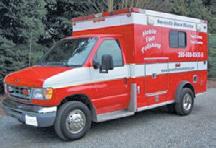
JUST THE MAGAZINE, PLEASE:
Our standard subscription gets you 12 months of 48° North and its associated special publications (SARC, Setting Sail, and the Official R2AK Program).
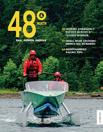

• $39/year (additional fees for First Class forwarding or International)
INSTALL
Business or Pleasure, AquaDrive will make your boat smoother, quieter and vibration free.
The AquaDrive system solves a problem nearly a century old; the fact that marine engines are installed on soft engine mounts and attached almost rigidly to the propeller shaft.
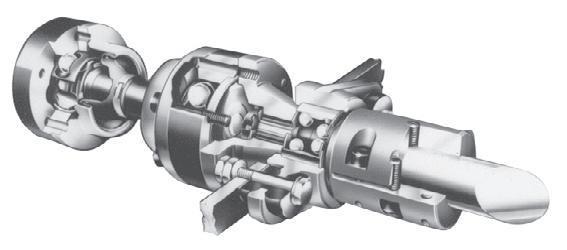
The very logic of AquaDrive is inescapable. An engine that is vibrating
on soft mounts needs total freedom of movement from its propshaft if noise and vibration are not to be transmitted to the hull. The AquaDrive provides just this freedom of movement. Tests proved that the AquaDrive with its softer engine mountings can reduce vibration by 95% and structure borne noise by 50% or more. For information, call Drivelines NW today.
Don't
Whether
“A‑Northwest Legend for Over 25 Years”

The day has come to untie those dock lines and head out on the water. As you motor out of your slip, the last things you want to think about are repairs, spare parts, or what could go wrong. But things do happen and it’s in the best interest of the boat and crew to be as prepared as possible — carrying engine spares is a big part of that preparation.
There is a long list of spares we could choose to carry. Still, when I am helping out folks on the water, they often don’t actually have what they need. It is important to prepare for the type of cruising you’re planning to do, so you have the right tools and parts while you’re away from the dock. Knowing how to install these items with the correct tools is also critical, since a mechanic is seldom nearby; or if there is one, you aren’t forking out “vacation” prices for a simple service.
Preparation does begin long before you are underway. While oddball things can fail, an engine that receives proper maintenance and an annual inspection should avoid most issues. Many things that fail are due to neglect, not random failure. But if you want to enjoy the wonders of cruising in the Pacific Northwest, it means declaring your preparations complete and heading out — hopefully with the appropriate redundancies and resources.
The following recommendations about spare parts and tools are cumulative, so be sure to include the suggestions for shorter cruises even if you are cruising longer distances. Starting with a focus on near-coastal and inland cruising, here is what I recommend having aboard when you leave the dock.
Many folks choose to do short runs, whether it’s a day trip or an overnighter for the weekend. Being close to home does not mean you’re immune from running into trouble. While a very basic list, these issues are the most common that I come across when people call me with spring or summer emergencies. Assuming your engine is reasonably maintained as far as hoses and general servicing goes, having this minimum amount of spares will, in most cases, enable you to limp your boat home without a tow.
Rigid external oil lines can and will break from rust or chafe, if not inspected or maintained. I have also seen a few oil plugs/oil pressure sending units literally blow out. The typical result is that all the oil is lost in a matter of seconds.
It goes without saying that you cannot run your engine in that condition. Hopefully, you will be able to plug the hole to get them home, but in order to do so you must have spare oil on hand.
by Meredith AndersonEspecially if your boat has been sitting unused for a while, getting underway can stir-up algae and other crud in your fuel tank, mixing it with your diesel. As such, be prepared with one complete set of replacement fuel filters for whatever filterset you’ve already got. Having more than one of each is better, especially if the tank is dirty. Changing filters usually requires bleeding the fuel lines for the engine to run smoothly again, so there’s also a key skill that comes with these physical replacements.
Nothing stops the fun faster than no water coming from your exhaust. A failed impeller is easy to fix, as long as you have a replacement that fits your engine with you.
AT LEAST ONE OF EACH TYPE OF BELT THAT THE ENGINE MAY HAVE
Belts often go neglected and tend to break when used for the first time in a season. Also, it’s important to know how to change your belts and how much tension they should have.
For longer trips up to and beyond the San Juan and Gulf islands, it is important to bring a few more items. These beautiful places often bring you farther away from easily accessible parts and services, but not so far that you will be completely on your own when it comes to repairing the basics on your engine.
I tend to plan routes in such a way that I have checkpoints along the way to my destination. Though I know of various places to stop and buy or order parts if I need to, it’s best to have the basics covered, including tools to remove and install these things if I am at anchor with no one close by. Towing is truly a last resort, and waiting for parts at marinas far from your homeport is expensive.
The items below are things I actually carry while cruising
north each summer. Most of the larger maintenance items such as injectors, hoses, and exhaust elbows have hopefully been usually replaced throughout the year so they are not a problem while underway.
It is easy to find wire-reinforced or rubber hoses in many places around Puget Sound, but not so easy to find engine specific pre-bent cooling hoses, because most places do not stock these and will have to special order them. If a pinhole in the heat exchanger forms, you will likely need to replace coolant more often until the heat exchanger can be replaced. Additionally, hoses that have been on the engine for a long time will most likely be damaged in the process of removing them, so it’s handy to have these ready to go when taking on this project.
Faulty glow plugs can leave you stranded at random, inconvenient, or even dangerous times. Those of you with Universals, Westerbekes and more modern Yanmars will have glow plugs. Some of us will have a relay, and those are notorious for random failures. Carrying a butane heat gun can help diagnose this too and even get you started if you don’t have a relay on hand. My Universal diesel engine had this problem last summer and I had to use my torch for a few starts until I had the time to replace the relay at the dock.
Universal, Westerbeke, Kubota, and Nanni tend to use breakerstyle circuit protection that is mounted on the back side of the engine. Carry an extra if your engine has one. If you have a starting battery fuse or breaker, it is also a smart idea to carry a spare.

Don’t get stuck with a leaking raw water pump. While this is not a critical issue, a leaking pump can lead to further problems if you’re cruising for several weeks. Having a rebuild kit or a spare pump handy can save you problems later. If you’re using a rebuild kit, remember you will need a gear puller and a vice to pull the drive gear in some cases, and a vice to press the shaft out.
Starters can randomly fail and, while some engines have a hand crank, most don’t actually have enough access to use the handle. I have a used spare that is functional so I can slap it on and go.
An ill-maintained prop can definitely fail under load. Also, a good hit with a log or other obstruction can also take out a blade
or the whole prop. While you may be able to limp into a marina, it sure is nice to have the spare on hand so you don’t have to search and wait for one while at a guest slip.
What cruiser doesn’t love the freedom of being away from the dock? It’s the feeling we live for! Whether in the islands or closer to home, these adventures require elements of self-sufficiency. Having some essential spares for your engine, and the tools and know-how to employ them is a central aspect of nautical self-reliance. The list of spares above should ably cover Salish Sea cruising. If you’re headed to much more remote areas, including offshore, the parts list and skill set becomes more extensive — which I’ll discuss in my next column. With routine maintenance at home and few parts and skills, you’ll be able to focus on the fun of cruising knowing you’ve given yourself a simple safety net.
Meredith Anderson is the owner of Meredith’s Marine Services, where she operates a mobile mechanic service and teaches handson marine diesel classes to groups and in private classes aboard their own vessels.

For nearly 20 years, we kept a series of boats at our homeport, Elliott Bay Marina; the latest being our 1984 Passport 40 Rounder. A few weeks ago, I backed out of our slip on J Dock, pointed the bow down the fairway toward the massive breakwater that has held dozens of storms at bay, and began slowly passing familiar sterns with their familiar names.
How many times have I traveled this same path to sailing adventures near and far? How many evenings have we sat in the cockpit watching the lingering sunsets over the Olympic Mountains? How many times did I fall into conversations with perfect strangers about the weather, cruising plans, or the latest improvement project? How many harbor seals have popped their heads up to say hello? How many times have I paused under the little gatehouse roof at the top of our dock to enjoy the hanging flower baskets in summer, or for temporary relief from the wind and rain in winter?
There was no fanfare, no music, no goodbyes from neighbors or staff. I just quietly left our homeport, for good this time.
There are an endless number of topics we discuss and obsess about as boaters, from destinations and weather to motors, batteries, and the latest must-have technology. But the one topic that I haven’t given a lot of thought to is the marina where many of those topics have been discussed.
After all, for those who keep their boats in the water throughout the year, a homeport is the place where your boat likely spends most of its time — and for us, who have lived aboard for months at a stretch in the past, where we did as well.
Perhaps those of us who cruise a lot are conditioned to view marinas as transactional places. You pay someone to let you tie your boat up for a night or two while you run errands, fill the water tanks, and top up the battery bank.
But when you love the marina where you keep your boat, it becomes a far more meaningful place.
This idea dawned on me recently when, after decades of living in Seattle, we sold our townhouse and moved to a new house on Bainbridge Island. At first, we decided to keep the boat moored at Elliott Bay Marina with the assumption that we would use it as a little home away from home after a night out in the city or a visit with my mom just up the road in Ballard. My wife, Deborah, dubbed it our “pied-á-mer.”
But we found we used it as such far less than we thought we would. And we learned the hard way just how messed up the ferry service between Seattle and Bainbridge can be on weekends, when we typically wanted to visit the boat either to use it, enjoy it, or work on it.
When my mom passed away late last year, I just couldn’t see a good reason to keep the boat there any longer. I mentioned to Deborah that we could start looking for a marina on the west side of Puget Sound, closer to our home.
She wasn’t enthusiastic about the idea.
Our dating relationship had just become a serious relationship back in 2004 when we last switched marinas. I had lived aboard for years at Lee’s Landing, a charming, family-owned marina under the Aurora Bridge on Lake Union.

That marina was where I started learning how to own and skipper a sailboat. Getting into the slip wasn’t exactly easy, requiring a tight turn that brought the stern within kissing distance of the floating home across the fairway from me. I’d wave at my neighbor, who probably never stopped worrying that I would shatter the kitchen window with my dinghy davits.
I loved looking at the cathedral-like arches of the Aurora Bridge soaring above me almost as much as I enjoyed the calland-response horns from boats transiting the nearby Fremont Bridge.
But that bridge and the Ballard locks seemed to lose their charms when they became obstacles to getting out on the
WHEN SWITCHING MARINAS IS MORE SENTIMENTAL THAN ANTICIPATED
wider waters of Puget Sound on weekends and vacations. So we decided to relocate our homeport to salt water.
I remember being gobsmacked by the splendor of Elliott Bay Marina when we first arrived. It was more like a nicely designed park than a marina. The grounds were immaculate, the parking was plentiful, and the views of the Space Needle and downtown Seattle were incredible.

We loved the low-key Thursday night sailboat races and the outdoor party that followed. We enjoyed getting to know the group of boaters who happened to moor near us on J Dock. Over many years, we met their families, watched their kids grow up, made lifelong friendships, celebrated holidays, traded sea stories, and shared tips on our favorite anchorages. We commiserated when the repair guy pronounced their engine beyond saving and celebrated when they hoisted those new sails for the first time.
People and boats came and went, but that sense of community in our little corner of the marina never changed.
I understood Deborah’s reluctance to say goodbye to the marina. Despite that, we decided we should at least explore options close to home.
And so on a Monday morning in January, I pulled together a list of marinas and started making calls, fully aware that most of them would not respond, or if they did, likely offer me condolences and a spot on the waiting list.
But then Eagle Harbor Marina called back. They had a slip available and asked if I’d like to come take a look. I jumped in the car minutes later.
I knew from my research that Eagle Harbor is one of four well-regarded marinas operated locally by the Marsh Andersen Company.
The drive from our house to the marina took exactly eight minutes. I turned down the narrow residential street leading to the marina, then into the ample parking lot. Across the bay, I could see the ferry dock and the old Elwha tied up nearby. Winter rowers were leaning into their synchronized strokes as the chase boat followed close behind. A series of dock carts were tipped up at attention by the gatehouse.
I walked down the ramp to the sturdy, recently built docks alternating between squares of concrete and salmon-friendly grates. As I made my way to the slip, I noticed that the electrical pedestals and the water standpipes were all in excellent condition. And in a sign of the commitment to clean water, each slip had access to a quick and convenient dockside pump-out.
There was no breakwater, but the high hills that rose above the marina to the south would be more than enough to handle any winter storm in the Pacific Northwest. I soon got talking with several resident boat owners, whose only complaint was that the huge dockside flower baskets in summer sometimes left petals on the deck of downwind boats.
I called Deborah and convinced her to come down to have a look as well. And within a few minutes, we decided to take the slip. It happened so fast that at first the magnitude of the decision hardly registered.
Were we really ready to leave behind a place that meant so much to us for so long?
A few days later, we cleared the breakwater at Elliott Bay
Marina for the last time, made the 4-mile crossing of Puget Sound, and nudged Rounder safely into her new slip at Eagle Harbor Marina.
I began to wonder, how many times would we leave this new slip for sailing adventures near and far? How many evenings would we sit in the cockpit watching the ferries come and go? How many times would we fall into conversations with our boat neighbors about the weather, cruising plans, or the latest improvement project?
There was no one to greet us that day. No band played. It felt a little strange tying up to the dock, looking around at the sterns of unfamiliar boats with unfamiliar names.
But it also felt right. It was time for a change. We had a slew of new memories to make. And with time, this marina, too, would transform into a homeport for the boat and for us.
Marty McOmber is a Pacific Northwest sailor, writer, and strategic communications professional. He is currently working on refitting and improving his 1984 Passport 40, Rounder, for continued cruising adventures near and far.

 by David Casey
by David Casey
“There was a Small Craft Advisory for Puget Sound and Hood Canal. Local winds are predicted to be 13-16 mph. That is why I selected the leeward side of Fox Island (Hale Passage) for today’s paddle. Does the wind get through to that side? Of course there were sections where the winds were felt but nowhere near what it would have been if we were fully exposed. Patrick (a fellow kayaker) checked out the windy side of the Fox Island Sand Spit and paddled over to the calm side before we departed. There were a couple of sea lions out there checking him out.”
For the ultra-fit 68 year old, kayaking began as something to do on his time off from delivering mail. Since he walked all week on the job, hiking held no allure. But the upper body workout that comes from paddling and the effective use of core muscles in the torso were appealing. Combine that with a therapeutic recovery from his rotator cuff surgery in 2010 and Kaz was all in!
Afew years before Ariel , our Columbia 28 sailboat, became part of our world, my wife and I explored the local lakes of Sonoma County, California on a sit-on-top inflatable kayak called an Advanced Element. When we moved to the Pacific Northwest to be closer to our son, we realized that we had a lot to learn if we were to continue our paddling adventures on the Salish Sea.
Our first venture onto Commencement Bay with our tandem kayak was tenuous, and even a bit unnerving. We resolved to gain a bit more knowledge of the area, hoping to find others with local experience. Fortunately, we soon got to know Kazuhiko Griffin, or “Kaz,” as he is known to his friends and family, who became a good friend and deepened our understanding of the equipment, knowledge, and experience of kayaking in the PNW.
We first met Kaz, a retired postal delivery man, about three years ago while walking around the neighborhood on one of our frequent trips to Tacoma to visit our son. He was out in his front
yard, installing stepping stones across the sidewalk median strip, one of many DIY jobs in which he demonstrates his construction skills and his creativity.
Speaking with both confidence and humility, Kaz gave us a little background on his yard improvement project and his life in Tacoma with wife Sandy, son Kazuhiko, Jr., and daughter Allison. Kaz is a dyed-in-the-wool tinkerer, with evidence of his handiwork seen in the camper top of his 1975 Ford 150 pickup truck, the traveling home of his NC 15foot kayak. However, on that day the truck bed carried varying sizes of lumber for his yard project.
It didn’t take long before the conversation shifted to kayaking, with Kaz energetically recounting some of his recent paddling excursions with an informal club that he had created. He invited Laura and I to join. Kaz sends weekly emails out to all of the folks on the list, informing them of a departure location, route, and weather conditions, along with some of his personal editorials, as seen in the following excerpt from one of Kaz’s recent messages:
The first time that you meet the avid kayaker you feel like you’ve been friends with him for years. His exuberant and effusive demeanor radiate equally to anyone in range. We’ve gotten to know Kaz better on a few kayaking excursions, and even playing a little ping pong in my garage.
Sometimes on a walk, we run into Kaz and Sandy on their weekday bicycle rides along the Point Ruston waterfront. (Now that he’s retired from postal deliveries, he doesn’t mind the lower body workout.) We notice that he’ll strike up a conversation with a stranger as easily as an old friend, and more often than not he’ll take your picture. Kaz never goes anywhere without his camera, taking stills or video of friends or wildlife along the shore. But more than anything, his favorite scene to record is the waters of Puget Sound, and he keeps an extensive and complete documentation of his weekly paddling ventures.
While he doesn’t have a favorite route, Kaz spends most of his time around the Tacoma peninsula, rarely driving far for his launches, which usually take place from Owen Beach, Titlow, and the Ruston Way waterfront.
He has on occasion driven to Shelton and Southworth, but the long drives on highways take time away from relaxing
paddles on the water. Kaz would much rather utilize the beautiful, close, and available bays and inlets than drive to destinations farther away. Additionally, Kaz advises, “familiarity with local waters increases awareness and hence, safety.”
Reviewing his logs since he began his kayaking hobby in 2011, Kaz can accurately report over 700 paddling excursions in those nearly 12 years. He began those adventures in an Equinox 10foot recreational kayak from Costco, using it for nearly 9 years and 549 recorded outings.
His current boat is an NC Kayaks 15, a fiberglass vessel which he serendipitously obtained in December of 2019 from Travis Goldman, the owner of NC Kayaks. Kaz met Travis on the water, of course, as he was returning from his weekly constitutional in the waters of Dalco Passage, just south of Vashon Island.

After a few shared paddles in the next couple of months, Travis offered Kaz a slightly blemished, almost-new sea kayak in exchange for feedback on the protype connection between the hatch and the hull. NC was experimenting with adhesives to make the bond, and Travis figured that the permanent loan to Kaz would take the kayak through its paces out in the open water.
Initially, Kaz was undecided about the V-shaped, curved hull. It was tippy at first, making it easier to capsize than his previous vessel. But the avid paddler concedes that it is faster. And after 158 outings on the streamline kayak, Kaz is not turning back. Although true to his humility, he still believes that he doesn’t deserve to be paddling such a nice kayak.
Safety is of paramount importance
to the de-facto group leader and his fellowship of paddlers. To the point, his favorite book about kayaking is The Sea Kayaker – Deep Trouble, a book that deals almost exclusively with safety.
In addition to the requisite life vest, Kaz carries a waterproof/floating charged VHF Radio (tuned into Channel 16), a whistle, an extra paddle, a first aid kit, a signal mirror, a paddle float (for self-rescue), his cell phone, navigation charts, along with a water bottle, fruit and other snacks, depending on the length of the trip. His camera sits perched atop a small tripod affixed to the foredeck of the kayak.
He’s been accused of carrying everything but the kitchen sink. “But,” says Kaz, “If you don’t take it, you don’t have it.” He recalls going for a paddle with a friend a few years ago. “The only problem,” said Kaz, “was that he forgot his paddle in his car. So there he was, literally ‘up a creek without a paddle.’” Kaz just gave him the spare paddle that he had packed and off they went.
To fend off the cold of Pacific Northwest winters, Kaz layers up with two wetsuits — a 3mm Farmer John and a 3mm shorty below his outer layers. He completes the ensemble with neoprene booties and appropriate head covering, based on the weather report for the wind, temperature, and water conditions.
Kaz — and nearly every other boater that we have met — reminds Laura and I of the three most important things to remember when on the waters of Puget Sound: don’t fall in, don’t fall in, don’t fall in! With water temperatures around 50 degrees, hypothermia sets in, muscles cramp, and drowning can occur within minutes.
With his camera always at the ready, Kaz caught this stunning reflection of the Tacoma Narrows Bridge.

Should disaster strike, Kaz and his fellow paddlers are prepared. He puts together an annual practice rescue drill for anyone on his email list. The drill starts with a shoreside demonstration of the technique to empty an overturned kayak of water and then climb back into the vessel. Then, with other kayakers in the water just off the shore, the practitioner paddles into the 6-10 foot depths and proceeds with the drill in the water. Returning to the cockpit is probably the most challenging part, although spending a minute or two in the ice cold waters is a close second. Bystanders at last year’s drill, we were impressed with the commitment of these amateur boaters in the informal club, as they volunteered to practice the maneuver.
While it seems like his dedication to kayaking would supplant his approval of any other sea craft, Kaz always encourages Laura and I to participate in boating activities any way that we can. His daily bike rides take him by the marina that berths Ariel, allowing him to check on her and remind us when she is missing our tender loving care.
We have yet to have Kaz and Sandy out on our Columbia 28, although not for lack of trying. Yet for all the wonders of sailing, I’m sure he’ll miss the feel of a paddle across the bow, a watertight spray skirt around his waist, and the splash of the cold waters of Puget Sound on his face.
David Casey is a retired math teacher and semi-professional woodworker and bass player. He plans on using his retirement to build a small sailboat and a kayak, and to explore the waters of southern Puget Sound.
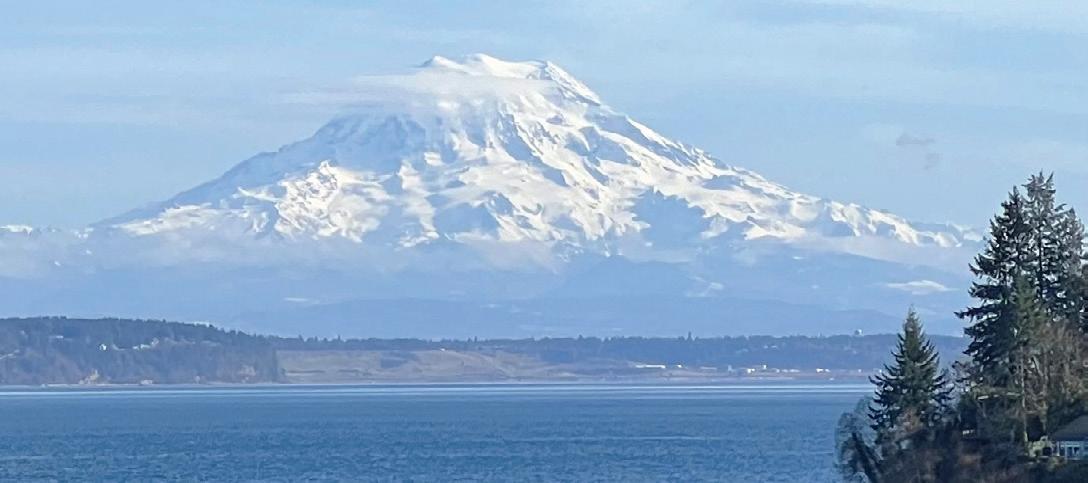 by Lisa Mighetto
by Lisa Mighetto
You know a place like this. It is a secluded, cherished cove seemingly frozen in time. Most boaters have at least one. Mine is located on the east side of the Key Peninsula in south Puget Sound. The site is hardly a secret — it includes a highly-publicized state park — yet it remains an “in between” spot, off the heavily trafficked route between Olympia and Tacoma. My husband Frank and I spent a memorable weekend here with our friend Mike, who camped on shore near Murrelet , our docked sailboat.
Mike drove his truck while Frank and I arrived as we often do — by water. Coast Salish canoes made of cedar have landed in this spot for centuries, bringing Sqauxin, Nisqually, and Puyallup people to harvest salmon, gather shellfish, and trade. Settler colonists came by boat in the days before paved highways allowed cars to probe the nooks and crannies of the South Sound.
“How do I get there?” asked Mike when I invited him to join us on the key-shaped peninsula extending into Carr Inlet to the east and Case Inlet to the west. His question stumped me. Here is what I knew: sail east through Dana Passage, round Devil’s Head, then cruise northward through Balch Passage and around Penrose Point. Of course, such directions were not helpful to a driver. Like many places in the Salish Sea, Mayo Cove is best approached in a boat, chart in hand.

At first, we are disappointed that it is raining. Water flows, trickles, drips, and condenses throughout Mayo Cove, seeping into everything: the structures dotting the shoreline, the wooden docks, our boat, even our foulies. The three of us decide to explore anyway, climbing into the dinghy and leaving Murrelet at the Penrose Point State Park dock. The depth is shallow here, and we poke through the marshy vegetation, admiring the deep greens of the Douglas fir and cedar trees and the yellows and reds of the late September maples. We pass a boathouse that had seen better days. “How old is that?” Frank asks the two historians on board. “Probably built last year,” jokes Mike, noting that water seems to weather a building faster than any other element.
In Mayo Cove, the old and new blend seamlessly, making it easy to imagine the scene before us in previous eras. This is a good place to read the waterscape, and we spot evidence of past logging and farming, including stumps, berms, and remnants of orchards. Turning west, we notice old pilings under a dock at the Lakebay Marina, and stop to investigate a store at the deep end of the pier. Inside, the elderly proprietor serves us coffee and informs us that this once served as a landing for the Mosquito Fleet.
The Mosquito Fleet, a group of steamers and sternwheelers, carried passengers and freight throughout the waterways of Puget Sound during the early twentieth century, stopping at various settlements. While the original pier at Lakebay in Mayo Cove dates from the 1880s, the main building on the wharf was erected in 1928 and housed the Washington Cooperative Egg and Poultry Association. Here the Mosquito Fleet picked up local eggs, which were distributed throughout the region and transported to the East Coast and Europe, where inexpensive protein was highly valued during the Great Depression and World War II. Many residents of the Key Peninsula were members of the co-op. “The eggs were called cackleberries,” Catherine Williams, president of the Key Peninsula Historical Society, explained recently. “They had so much fruit out here… so why not?” (Key Peninsula News, April 1, 2019).



The co-op became an important site for social activities on the peninsula, attracting people to the pier and building. According to Williams, they arrived by boat, as the dirt roads were often muddy. Virginia Seavy, who arrived in Lakebay in 1918, recalled that “there were very few roads — mostly trails in the woods.” By the late 1950s, a network of paved highways and bridges had connected the Key Peninsula with the outside world, and the co-op’s Lakebay station closed. Throughout the late twentieth century, the dock and warehouse operated as a marina. The Pierce County Register of Historic Places listed the site in 2019, recognizing its significance in the development of
the South Sound.
Across Mayo Cove just a few yards from the marina, the area around Penrose Point became a state park in 1987. Stephen Penrose, president of Whitman College, had owned this site, bringing his six children here every summer during the early twentieth century. The Penroses typically arrived on the steamer Tyrus to reach their family camp. Thanks to the state park, kids today continue to play on the shoreline and explore the forest trails winding along the water.
The combination of marina and park makes Mayo Cove an ideal destination for cruisers, offering early waterfront charm in a rural setting, as well as boating amenities. Penrose Park State Park provides docks on the Mayo Cove side, while buoys lure boaters to the Carr Inlet side. So appealing is the location that the Salish 100 small boat cruise stops here on its annual voyage from Olympia to Port Townsend. It is a perfect meeting spot for boaters and those arriving by land, which is what drew Frank, me, and our friend Mike here.
The last stop on our dinghy ride is Von Geldern Cove (also called “Joe’s Bay”), just around the bluff on the northwest side of Mayo Cove. We putter toward the waterfront community of Home, armed with our well-worn, rain-soaked copy of Bailey and Nyberg’s Gunkholing in the South Sound, which informs us that this was once a “haven for free thinkers,” including vegetarians and nudists. As we glide along the forested shoreline, I read aloud to Frank and Mike, recounting how this quiet community made a splash in the region’s history.
Home was one of several utopian communities that emerged in western Washington during the late nineteenth and early twentieth centuries. In 1898, a group of settlers formed the Mutual Home Association, which intended to bring together individuals who valued “maximum liberty” without central organization or government. Local newspapers with evocative titles like New Era and Discontent: Mother of Progress, examined anarchist ideals and reported on the progress of Home, hoping to attract like-minded people.
Jay Fox, a Chicago anarchist and editor, arrived in Home in 1910 and began publishing The Agitator. “Home is a community of free spirits,” he explained in an issue in 1911. Its residents “came out into the woods to escape the polluted
atmosphere of… conventional society.” The Agitator was filled with passionate and colorful rhetoric. Fox described President Theodore Roosevelt, for instance, as a “blatherskite,” “jabbering jawsmith,” and “inflated windbag.”
By 1910, Home had reached a population of 213, with nearly 70 residences. That year, Lucy Robins Lang and her husband Bob arrived in Joe’s Bay on a steamer, hoping to stoke their interest in anarchism and put down roots. The couple had lived in New York, Chicago, and San Francisco, demonstrating the connections of Home to the larger world. “We felt at once the fine atmosphere of freedom,” she wrote. “When we looked out… at the snow-covered peaks of Mount Rainier, glistening like a tiara of diamonds, we were sure that we should want to live here for the rest of or lives” (Lucy Robins Lang, Tomorrow is Beautiful, 1948).
Yet Lucy and Bob soon noticed “signs of strain at Home Colony.” External threats included national concern about the 1910 bombing of the Los Angeles Times building by labor activists, which cast suspicion on several Home residents. Around the same time, an internal rift between the “nudes” (those who wished to bathe naked in the waters of Joe’s Bay) and the “prudes” (who watched the unclothed with indignation and horror) emerged. Fox’s editorial on the controversy, which began “Clothing was made to protect the body, not to hide it,” got him arrested. He left Washington soon after, as did the Langs. In the end, the Home Colony “proved too much of a disillusionment” for the couple. In 1919 the Home Association dissolved, and the anarchist community broke apart (Lucy Robins Lang, Tomorrow is Beautiful, 1948).
Frank points our dinghy toward Carr Inlet, heading back toward Mayo Cove. The clouds have lifted and Mt. Rainier towers above the water. This is the scene that had enchanted Lucy Robins Lang, fueling her utopian dreams. That night, we build a campfire on shore and toast the early seafarers of Mayo Cove and the free spirits of Home.
Recent efforts to bring Lakebay Marina back to its former glory will ensure that this historical site continues to charm boaters and inspire excursions like mine. The Recreational Boating Association of Washington (RBAW), Washington State Parks, and Washington Department of Natural Resources (DNR) have joined forces to preserve the pier, building, boat ramp, and tidelands for public recreational access. The marina has been purchased and the restoration project, which will likely take 3 to 4 years, has begun. While the site’s components have deteriorated over the years, the marina retains much of the character that has made it a beloved landmark for boaters and locals.
Commissioner of Public Lands Hilary Franz, who oversees the DNR, praised these efforts. “I love this facility and the value it has for recreational boaters in the South Sound,” she commented recently, adding that “the history of this facility is… critical to hold onto” (Key Peninsula News, January 1, 2022). Andrea Pierantozzi, vice president of the RBAW, agrees. “We’re creating a South Sound boating destination that keeps the look and feel of the past,” she explained. “The goal is to convert this gem into a marine park” with boating opportunities for generations to come (personal communication with author).
Bob Wise, president of the RBAW, compares Lakebay Marina to Sucia Island, which has become a favorite place for boaters in the San Juans. In 1960, the parent organization of the RBAW purchased and donated Sucia to the state, to be managed for public use. The hope is that the waters around Mayo Cove, enhanced by the restored marina and adjacent state park, will fill a similar role as a key destination in the South Sound.

Lisa Mighetto is a sailor and historian living in Seattle. She is grateful to the Key Peninsula Historical Society for images, documents, and stories.



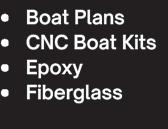
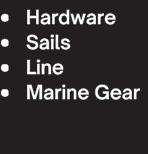







 by Mac Fraley
by Mac Fraley
The lightning started at 1 a.m. on night four of our 600-mile offshore passage from Craig, Alaska, to Neah Bay, Washington. We were 40 miles west of Vancouver Island and our 50 foot aluminum mast was providing the highest point within hundreds of square miles. As lightning provided the only light in an otherwise pitch black environment, my wife, Jenny, and I, sat huddled underneath the dodger, questioning every decision made that led us to that moment. Below deck, our dog, Disco, was undoubtedly questioning her loyalty to us as we slowly made our way towards shore, waiting to be struck by lightning and swallowed up by the cold, dark sea.
How did we find ourselves in this situation? In late June 2021, we embarked on a path less traveled to return to Washington from a season cruising Southeast Alaska aboard our 1980 Alberg 37, Maya. As many Pacific Northwest boaters know, British Columbia’s section of the Inside Passage offers an excellent route when transiting to and from Alaska. That path provides shelter from the mighty Pacific Ocean and many safe anchorages in which to rest along the way, not to mention breathtaking scenery and wildlife.
The Inside Passage was the route we selected for our journey north from Anacortes, Washington (see “Cruising in Closed Waters” 48° North, January 2022). At the time of our departure in the early spring of 2021, the border between the U.S. and Canada was shut down due to Covid-19. Fortunately for us, the Canadian Border Patrol allowed us to pass through their waters under the stipulation that we make no unnecessary stops and that we not step foot on land except for fuel and water. No problem. We complied and 18 days later (5 days of weather delay) we arrived in Ketchikan, Alaska ready to spend the season cruising Southeast Alaska.
The idea to take the offshore route back arose even before we arrived in Alaska. Instead of spending two weeks transiting the myriad of fjords, motoring for long stretches, and endlessly scanning the water for logs and debris, we figured, “Why not do a straight shot home?” That would afford us an extra week to enjoy Southeast Alaska. We had spent so much energy to get up there, we might as well stay as long as possible.
The offshore route was roughly 600 miles, which we estimated would take us 6 days. As you’d expect, we had lots of questions: Can we handle a passage

like that? Probably. Did we have any overnight sailing experience? No. Did we have any offshore experience? Well, sort of… Our circumnavigation of Vancouver Island a few years back gave us about 200 miles of the open ocean experience, although it was never at night and we carefully picked our travel days. At least we could call ourselves accomplished sailors though, right? Not exactly. We had spent the last few summers cruising, but we never considered ourselves diehard sailors. We often opted to use our boat’s 30hp diesel if conditions weren’t ideal. We had flown our spinnaker a handful of times, but we hadn’t gotten around to experimenting with the pole.
Even though we were a little green for a trip of this magnitude, there were positives. Maya is a great boat and, while she is what some would consider vintage, is well constructed and designed for offshore use. We also know her very well. We’d been living aboard Maya for several years, managing all the maintenance ourselves — electrical, mechanical, rigging, and so much more. Maya was in good shape and she was ready to be offshore.
Another incentive was that we already had plans to sail Maya to Mexico in just a few months — a journey which, of
course, would take us offshore. Why not just jump into this whole offshore thing a little early?
All of these questions played in our minds the entire time we cruised Southeast Alaska, and we waffled about the ideal return trip route. Ultimately, the desire to spend more time in Alaska won and we decided to go offshore on our way home to Washington.

So, after several months of wonderful cruising, we positioned ourselves in Craig, which would serve as our launch point for the southbound voyage. Tied to the transient dock of North Cove Harbor Marina, we stowed all unnecessary items from the deck, including the outboard engine, fenders, and grill, which all fit in the V-berth. We assembled a ditch bag, ran jacklines from bow to stern, and put up the lee cloth to make our seagoing berth in the salon. We had been in contact with a weather router and it looked like we had a decent weather window. The night before launch, we put on antiseasickness scopolamine patches in preparation for the ocean swell, although the medicine did nothing to calm our nerves. This was it. We were ready.
At 6 a.m. on the morning of June 26, we untied the lines and shoved off the dock, slowly motoring away from Craig in thick
fog. Passing through Ursua Channel and into Bucareli Bay, the fog began to lift and the offshore breeze started to fill in. It was here we got our first taste of Pacific swell. With northwest winds around 15 knots, we hoisted the sails and began cruising south.
Day one was sunny and the sailing was brisk. With good wind off our starboard quarter and the swell pushing us along, we were steadily making miles toward our destination. To port, we got our last view of Alaska as we passed by Forrester Island, which was draped in a dramatic layer of cloudy fog. Farewell, Alaska, you’ve been wonderful.
On that first night, we entered the outer reaches of Dixon Entrance, the wind picked up, and the sea state became much more pronounced. We reefed once; then put in a second. Finally, with winds consistently at 30 knots, we put a third reef in the mainsail. And there we sat in the cockpit, wet and freezing cold, rolling back and forth in the swell in the absolute middle of nowhere. I would love to say we confidently and bravely rode out that night, but most of my thoughts were of the “what the hell am I doing out here?” variety.
As dawn approached, the winds decreased, the sky lightened and we
were treated with a sunrise over the mountains of Haida Gwaii. We had put Dixon Entrance behind us and had survived our first night passage! It was one small step for this passage, one giant leap for our cruising careers. Now, we only had four more nights to go.
The next two days saw us making good progress south. The winds calmed down considerably, forcing us to rely on the engine, however the seastate never seemed to relent. Thankfully, the weather was mostly clear — the sunrises over the mountains and sunsets sinking over the endless Pacific were stunning. One pleasant surprise was the amount of daylight we had. Since it was late June at
northern latitudes, we only had several hours of complete darkness before the sky would lighten as dawn approached.
As day four arrived, the weather changed. We were about 50 miles northwest of Vancouver Island’s Cape Scott when the clouds rolled in. During the course of this passage, our only means of communication with the outside world was through a Garmin InReach device which allowed for basic text messages. We had been in close contact with our weather router as well as another sailor friend who had been keeping a close eye on the weather for us. Almost simultaneously, we received texts from both alerting us to a fast
approaching storm front. The forecast was calling for southeast winds, rain, and possibly lightning.
Equipped with this information, we reefed our sails and continued on our course waiting for the storm to hit. Jenny woke me up around 1 a.m. to let me know that the lightning was here. Lots of it. Poking my head out of the companionway, a bolt of lightning streaked across the sky followed by a thunderous boom. The storm was real and, just as forecast, it had arrived. Quickly donning my foul weather gear, both Jenny and I huddled under the dodger as the rain came down in sheets and the wind howled — all the while, the lightning and thunder blasted on.
We elected to turn east and head directly to shore. We could deal with the wind, rain, and sea state, but the lightning… we were helpless against that. I am not an expert about lightning, but I am fully aware that tall metal objects attract lightning. With our aluminum mast 50 feet in the air, and the tallest thing in at least a 40 mile radius, we felt exposed and worried. We motored Maya toward shore, where we could at least be surrounded by land and trees taller than us. There was one small problem with our plan, though. We had not checked into Canadian customs and therefore we were not allowed to be there. However, when faced with the proposition of being struck by lightning in the middle of the ocean, and bureaucratic customs issues, the latter was by far more appealing.
As luck would have it, about 10 miles off Vancouver Island the lightning dissipated and the sky lightened. The storm had passed. Both Jenny and I had been up all night and were completely exhausted. Nothing sounded better than dropping the hook and resting in a safe anchorage, but with the storm now behind us, the thought of illegally entering Canada was a much bigger deal.
Begrudgingly, we adjusted our course to the south and continued on. The storm left an unpleasant and jumbled sea state, and essentially no wind. Still exhausted, we motored, happy to accept rough seas in place of lightning.

Day five quickly turned into night five and then day six. We entered the Strait of Juan de Fuca, carefully timing our crossing to avoid the steady stream

of tankers and big ships transiting in and out. That afternoon, we pulled into Neah Bay, Washington and dropped the anchor. We had done it. Our first offshore passage was in the books and we were back in Washington.

Having accomplished our goal, we look back now with some lessons learned from the experience. First and foremost, the scariest and most uncomfortable part of the whole trip occurred before we even left the dock in Craig. The weeks leading up to our launch day were filled with anxiety and doubt about our decision to go offshore. While our guts told us it was the right move, our minds would not let us rest, brewing up all sorts of terrifying situations to push us back down the safe and standard inside route. Almost all of those thoughts vanished once we were on our way — actually doing it was far easier than dwelling on the scariest wonderings about the unknown.

Secondly, reaching out to fellow sailors in the community provided helpful insight about what we could expect out there, and was instrumental in our decision to go offshore. We got into contact with several people (including 48° North Editor, Andy Cross), and they each had positive and encouraging words for us. Just knowing that others had completed a similar route was extremely comforting and made everything feel less daunting.
This passage was a major milestone for me and Jenny. We had gotten into cruising only a few years prior and, from the very start, it has been an educational journey that has led to immense growth. I can recall losing sleep for weeks prior to backing out of our slip for the first time, terrified of hitting another boat or making a mistake. In hindsight, I have to laugh about how nervous I was to simply back out of a marina slip, but the terror was real. We eventually did back out of that slip, thus taking our first step on a much bigger adventure. Over the years, cruising has continued to present these situations, often forcing us to second guess our skills and abilities when facing a new challenge. And yet in practice, every time we have pushed past those fears, we’ve been rewarded with rich experiences and further developed our skills, allowing us to tackle bigger and
more challenging goals. We are still not the best sailors, we still get nervous, and cruising still challenges us. Through those moments of struggle, however, I can wholeheartedly say that it’s all been worth it. Now, we very much look forward to the next horizon… hopefully free of lightning.
Mac, Jenny, and Disco have continued to cruise aboard Maya, most recently spending several winters cruising Pacific Mexico. You can find videos, photos, and lots more about their travels at www.cruisingmaya.com and www.youtube.com/c/cruisingmaya.
 by Andy Cross
by Andy Cross
Like many sailors, I love sailing fast. I love the interaction of wind pressing on the rig, flowing through the sails, and water rushing by the rail. Sending it downwind with a spinnaker up in a big breeze always brings me back for more. Racing on the ocean or around the buoys, getting every last bit of speed out of the boat as possible, is positively thrilling to me. Yet over my years cruising the Pacific Northwest, I came to truly appreciate the times when I needed to brush the hellbent racer in me aside and say, “You don’t need to sail fast to get somewhere special.”
So it was while ghosting over the top of North Broughton Island on a gentle following zephyr and a flood tide. Not far from our next anchorage in Greenway Sound, only the rustle of water trickling from Yahtzee’s stern could be heard. Shrouded in veils of misty fog, mountain peaks slid by and I watched as
our boatspeed leisurely climbed above 2 knots. Perfectly slow. As expected, a northerly breeze soon filled in and when we turned south into the sound we were welcomed by a pod of Pacific white-sided dolphins playing in our bow waves. Having our choice of spots to drop the hook with no other boats in sight, I felt like we’d found an idyllic place to laze away a few days before moving on. Indeed, we had.
Located in the northern section of the Broughton Archipelago — roughly 35 miles from Port Hardy — Greenway Sound is easily accessible from nearby Sullivan Bay Marina. A 6-milelong channel between Broughton and North Broughton islands, Greenway runs east-west for the first 3 miles before making a turn south for the last 3. At its elbow is the eastern terminus

“Hello, bears!” Porter called out in his biggest voice. “We’re here!” We never saw any bears.
of Carter Passage, which completes the cut that splits the land masses into two separate islands. Entering the sound, you can easily see why the word “green” was applied when naming this body of water. Much like the rest of the area, vibrant green rain forests flow from the mountain and hilltops down to the sea. And even though a fair bit of past logging activity is evident as you travel up and down the sound, its effects don’t diminish the overall beauty of the anchorages within.
Our first stop on this late June afternoon was at the eastern end of Carter Passage, just inside the mouth of Broughton Point. We tucked into a one-boat cove behind a tiny islet with suitable depths and swing room, dropped the hook and settled in. It was one of those out of the way places that was almost too good to be true.
Eager to explore the adjacent shoreline, we quickly dropped the kayak in the water and made for shore to poke around tide pools and stretch our legs in the forest. Under the canopy of tall cedar and fir trees, the mossy forest floor was the perfect playground for our sons, Porter and Magnus, to climb, jump, and balance on logs. Easily hike-able, which isn’t always the case in the Broughtons, we meandered up a hill and came across several piles of bear scat. It didn’t look fresh, but we did our best to make noise to let any nearby bruins know that we were hanging out near their home. “Hello, bears!” Porter called out in his biggest voice. “We’re here!” We never saw any bears.
Back aboard Yahtzee, Porter and Jill donned wetsuits and bravely swam in the sound’s not-so-warm waters as I fiddled with fishing gear. That evening, while enjoying dinner in the cockpit, the clouds parted just enough to reveal spots of blue sky and for the sun to make a brief appearance, giving us a shred of hope that it would make a glorious return the following day.
Alas, it was not to be. We awoke the next morning to the pitterpatter of rain dancing on deck, not the abundant sunshine that we were craving. Oh well, we’d have to wait a bit longer.
While planning our route through the Broughtons over the past week, Jill was fairly adamant that we visit Greenway Sound before leaving the area; partly because of a hike we could take on Broughton Island. We’re not big on setting hard and fast plans while cruising, but she isn’t one to steer us wrong either, so we brushed off the rain and motored eastward through the sound over glassy water to a large bay that dips south into Broughton Island on the east side of Greenway Point.
Many years ago there was a floating post office, store, and landing for steamships in the bay and at one point a small marina was operated here by a couple. Few remnants of this past activity remain, and a search on Google Maps shows it as Greenway Sound Recreation Site. What we happened upon was a very small float put in by the BC Forest Service that grants users access to two maintained hiking trails: one to Broughton and Silver King lakes, and the other to a lookout point over Broughton Lake.
With nary a boat to be seen, we dropped the hook, backed down and stern tied to the park float. Nobody else was around, so we figured why not? From the dock, we set out through lush green forests, over old logging roads and down a well marked




trail. This is what we had come for. Predictably, Jill nailed it.
The trail to the lakes was about two miles and of moderate difficulty. Along the way, we plodded past remnants of former logging activities as well as some limited park infrastructure — a few signs, picnic tables, and a small float to swim from, which is a lot for the Broughtons. The lakes themselves were set amongst a backdrop of cloud-swept forest with downed timber and green grasses accentuating the shorelines. It was beautiful, wild, and raw, just as you’d expect in a place as far removed as this. Had it been a warmer, sunnier day instead of a rainy one, I’m sure we’d have been swimming until our hearts were content.
After devouring lunch on a makeshift log table, we ambled back towards Yahtzee in no particular hurry. Porter scurried ahead and Magnus, as one-and-a-half-year-olds are wont to do, eventually fell asleep while I carried him down the trail. He woke up just as Yahtzee came into view through the trees and excitedly exclaimed, “Yahtzee!”
Returning back home, we decided that being stern tied to the small float wasn’t the best place to spend the night, so we weighed anchor and made for our last anchorage in the sound. Near the entrance to Broughton Lagoon are a couple of great spots to drop the hook. South of Cecil Island is a smaller, nameless island at the mouth to one of the passes to the lagoon. We dropped the anchor just south and east of this island and watched in awe as the tide ebbed and water dumped out of the lagoon, creating frothing whitewater rapids that were too enticing to ignore.
By the next day, the rain finally relented and Magnus and I jumped in the kayak to paddle over and check out the rushing water at a near low tide. Finding an eddy, I moved us parallel to the swift current and then turned sharply into it, which shot us back out into the anchorage with a scream of laughter from Magnus and a big “Woo Hoo!” from me. Not wanting to leave Jill and Porter out of the fun, we went back to pick them up so they could enjoy the ride too.
With the full crew and more paddling power aboard, we headed for the main pass into the lagoon and found it flowing even faster. Sticking to the side of the channel and out of the bulk of the current, we steadily worked our way into the pass through eddies and over a kaleidoscope of colorful barnacles, fish, urchins, kelp, sea anemones, mussels, and sea stars. It was like paddling on top of an immense aquarium.

When we’d gone as far as possible, we paddled into the current and shot back across to the other side of the narrow channel. I spotted a notch in the rocks that our kayak could tuck into and, from there, we were able to carefully portage over a break in the rocks to get into the lagoon.

Once inside Broughton Lagoon, we saddled back up and paddled around to where the current would spit us out near Yahtzee. As we reached the narrow pass between tall trees and steep rocks, we could tell the current wasn’t running as swiftly as before, but it shot us through in exhilarating fashion. What an adventure, which, given the rocks and turbulent current, I think could only be accomplished in a kayak or pack raft.

Following our whitewater exploits, we decided to slow it down a bit and found a quiet spot on a nearby beach to throw rocks, have a snack, and watch the tide come up. Much to our excitement, we also watched as the cloud cover broke apart to reveal a beautiful blue sky and brilliant sunshine. When the sun burst through, the previous days of gloom and rain were instantly swept from our collective memories as the warmth it created heated our bodies and dried our clothes. The water around us sparkled and the vegetation perked up and soaked it all in. Soon, a warm afternoon turned almost hot and we dashed to Yahtzee for our wetsuits and then over to an outcropping of rocks on the nameless island nearby for a swim.
By this time, the tide had come up enough over the large, sunbathed rocks to heat the water and create a perfect swimming area for us and a kiddie pool of sorts for the boys. Leaping into the clear, green water, we splashed, laughed and put the cap on yet another amazing day playing in the Broughton Archipelago.
That night, as I watched the sun set behind the mountains, I took a few minutes to reflect on all we’d seen and done in Greenway Sound over the past few days. From lazily sailing into the sound with dolphins to hiking the lakes, exploring the rapids of Broughton Lagoon and swimming in the cool water under the warm afternoon sun, it had been a time and place to remember. Truly, an unexpected gem — one of those payoffs cruisers often discover when taking it slow.
Andy Cross is the editor of 48° North. You can follow his family’s cruising adventures at SailingYahtzee.com.


Evergreen-studded islands, abundant wildlife and peaceful anchorages. Experienced or new to boating, we can help you discover the joys of cruising the beautiful San Juan Islands! Beginner to advanced liveaboard courses. Sailboat and powerboat bareboat charters. Guided otillas too!





As March drew to a close, so did Corinthian Yacht Club of Seattle’s Center Sound Series. Like the second race in the series, the final race allows the committee to determine the course on the day of the event, based on the conditions. Accordingly, the committee boat set the line several miles farther north than usual, anticipating more breeze to the north than to the south. Sure enough, when the course was set on the board, it was a 22-mile out-and-back run to Scatchet Head at the south end of Whidbey Island for the 60 boats across nine classes.

The moderate southerly hovering near 10 knots meant a downwind start — which always makes things a little extra exciting. Every kind of start was on display, from the early kite hoist with a speed-and-distance run to the line; to an approach from leeward of the line at the pin end, which puts a boat in a controlling starboard leeward position on all other boats. That is, if they can get back to the pin sailing up against an already pumping springtime ebb. In general, the pin was a very busy spot for these starts, and more than one boat, including the TP52 I was on, managed to be pushed down onto the start pin by the ebb. A penalty turn is not a very fast way to start a race.
Once we got off the line, it seemed like the middle of Puget Sound would provide stronger current and some models suggested the breeze should be better a little farther west too. As it happened, the course was pretty even, with possibly even a slight advantage in the first part of the run for the boats whose course kept them closer to the east side.
The breeze was quite consistent for the run north, so soon it was a boat speed game. Gains were minimal, but with more than 10 miles to work with, the faster boats did eventually eke ahead. Boat-toboat tactics played a role too — on Glory, we sailed a little deeper than we often do for a while, trying to affect the wind of some of our competitors to leeward.
As we approached Scatchet Head, the current was already causing fits as it pushed out of Saratoga Passage, moving boats westward at a healthy clip. With a dark current line to the northwest, the other 52s jibed away to the east; and on Glory, we decided to roll the dice with the split. It turned out that the current line also had a breeze increase, and we extended in the final half-mile on approach to the mark.
We managed to round ahead of our competition by a couple hundred yards, weaving through traffic of the other
classes to find a lane around. Once the kite was doused and we were back on the breeze, we let things settle and began the beat by extending southwest on the port tack we’d rounded on. As soon as Smoke and Mist rounded, they immediately tacked. We followed suit. Who could have guessed that those few hundred yards of separation would play such a role in the next leg of the race?
Trimming for speed and height on a close-hauled course to the southeast, the breeze built by a few knots, touching the low teens. It was about six miles on starboard tack as we chewed up the sunny wind waves toward Edmonds. We weren’t very far into this long tack when we started to worry about our position. The other two 52s were showing some mojo — gaining in speed and gauge. We adjusted elements of set-up, but never got rumbling enough to make up the differences. Ultimately, it seemed that our eastward competitors were continually getting the current advantages before we were in the remaining ebb, and were able to extend. Talking with sailors from other fleets reinforced this idea — the farther east you were on the beat home, the better.
By the time we tacked on the Edmonds shore, the other 52s had gotten ahead of
us. This was a big advantage with miles of short tacking ahead of us, where they would have a windward position. We tried mightily, but with the only option being short tacks along the shoreline eddy, our friends on the other boats were able to give us their dirty air the rest of the way.
Eventually, the breeze lightened, and the writing was on the wall with the committee boat fast approaching. We took a flier farther west, which didn’t pan out. We crossed the line in third, which wasn’t the result we hoped for, but our competitors had sailed well. Still, it was as good a day as you could ever want for a March sailboat race in the Pacific Northwest. For the series, the three TP 52s all scored 7 points total, with Smoke taking the tie breaker, Glory in second, and Mist third.
Happily sun-kissed and windburned sailors made their way south across the finish line. Most of the fleet behind us had to navigate dying breeze, and leads changed hands in the shifting conditions in several fleets. Top finishers for the day were Farr 395 Ace, Riptide 35 Terremoto,

Since this race wrapped up an excellent Center Sound Series, please join me in congratulating the best finishing boats overall. Across the three days of racing,


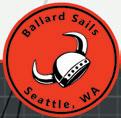


come a long way since our first Southern Straits in 2017, when every jibe felt like a liability. This year, as we approached the first mark of the course, we opted for a jibe drop, also known as a “Mexican”, to ensure that we didn’t lose our position. As the first medium course boat around, we were determined to maintain our lead.
The 2023 Southern Straits Race began in typical fashion, with pouring rain and no wind for 59 boats sailing four different distance racecourses. The forecast had predicted that light winds at the start of the race would steadily increase throughout the day and culminate in 30-plus knots early on Saturday.


Our team races the 36-foot J/111, 65 Red Roses II, out of West Vancouver Yacht Club (WVYC), and we chose to do the medium course this year. The 98 mile course would bring us from English Bay to Halibut Bank, down to an ODAS weather buoy between Point Roberts and Galliano island; then we’d sail back to Halibut Bank, west to Entrance Island, and across the strait to the finish in Vancouver. As we were leaving the club, we were treated to a surprise — four orcas — a sure sign of good luck!
The race start presented the same conditions that had challenged us in previous years. Two knots of current
pushing us over the line in light wind punished those who were aggressive on the line, so this time we hung back and nailed it, more or less. We were 30 seconds late to the line, but in clear air, which allowed us to overtake our competitors and catch the long course boats that were ahead. This is where the real race began.
With our light wind jib and a full main, we glided down current towards Point Atkinson, chasing patches of wind out of English Bay until we had enough to fill our spinnaker. Playing with the big boats now, we carefully jibed back and forth to find the wind between Point Atkinson and Bowen Island. Some boats, such as the J/109s and the other J/111, Valkyrie, dug deeper and found success along the shore, eating into our lead. We chose to position ourselves farther into the strait as we raced toward Halibut Bank.
With the wind ranging 5 to 8 knots, we were able to maintain our A1.5 spinnaker all the way to the mark. As a crew, we have

For those unfamiliar with a “Mexican,” it is like a weather takedown, but it is done when approaching the mark on starboard and a jibe is needed while then rounding the mark to port. During the turn, the spinnaker is over-trimmed, pulling the foot up to the deck. As the skipper completes the turn, the spinnaker inverts and lies on the new, windward side of the jib ready to be dropped. The name “Mexican” was coined by Buddy Melges during the 1992 America’s Cup trials in San Diego where prevailing winds would often point the bow towards Mexico during port roundings.
After rounding the Halibut Bank buoy, we hunkered down for the long leg to the new ODAS mark located at the southern end of the Strait of Georgia, west of the Tsawwassen Ferry Terminal. We chose to stay close to the Vancouver Island shore until we hit a wind shift near Thrasher Rock that forced us into an auto-tack. At this point, things started to get sporty. The breeze built and we were excited to see winds hitting 15 knots with gusts to 20. It was going to be a fun downwinder.
Here, our focus shifted to Valkyrie, who was cruising down the Vancouver Island shore and seemed to be gaining on us. Meanwhile, Ultraman III (S-40 MOD) and Joy Ride (J/122e) were just off our stern. As we approached ODAS, we frantically calculated wind angles to see
if we could hold a kite back to Halibut. As it didn’t look promising, we decided to try something new, a combination of the A3 and staysail, which allowed us to hold a high lane in 22 knots. As the wind lightened, we were able to peel to our A1.5 and lay the mark. It was interesting to observe the sail configurations behind us, with our competitors Valkyrie and Ultraman III flying spinnakers, each boat having moments when the conditions allowed them to gain and other times to lose ground.
As we approached Halibut Bank in the dark, we had a new problem to contend with. Phoenix (XP44), a long course boat, was coming up from leeward with rights. We had to ensure we established overlap with the faster boat 200 meters out from the mark, or we risked having to slow down and let them round 40 meters ahead of us, as per Appendix RV (Reduced Visibility Racing Rules) IRPCAS. Overlap established!
Another Mexican drop, this time in the dark. We hoisted our J1 and sailed to Entrance Island, rounding the PE and PO buoys near Entrance Island to port while wondering which set of bow lights behind us was our competition, and how far back were they? Impossible to tell. The wind went aft once we rounded PO and we decided to try our A3 again, but it wasn’t the ticket this time. The local pressure forced us too far south with big puffs knocking us down and we couldn’t find a groove to take us home. We tried adding our staysail but eventually decided to hoist our J2 for the final stretch.
Aside from technical aspects, another key in successful racing is keeping the crew in good spirits. We are a relatively bare-bones operation with all nonessential items offloaded for racing. Nevertheless, we are a happy crew. With a plentiful offering of sandwiches and wraps, hot pasta for dinner, fresh fruit, homemade cookies, and a wide assortment of snacks including crew favorite, Mr. Noodles, there is never a risk of mutiny. Kudos to fellow crew, Nicole, for keeping us so well fed!
Back on the course, it was around 11 p.m. and we had started a long starboard tack slog — a drag race home — with cold crew on the rail and cold hands in the cockpit. We all agreed we were glad
we weren’t on the long course! Despite seeming like a one tack approach to the finish, somewhere south of Roger Curtis we encountered a big knock, begging us to tack on it. Our tactician said no, we’re going to sail up behind Point Atkinson and ride the lift around the corner like we’ve done so many times before. A critical final call that we think gained us some crucial minutes on the boats chasing us down.
And so, a couple short tacks in our home turf and we were across the line, feeling
confident in our performance, happy to be finished, and ready for Mike’s hot soup at WVYC! At this point we knew we’d won line honors for our course, but it wasn’t until Saturday afternoon that we’d learn we won our division and the overall for the medium course. Another spectacular Southern Straits is in the books, and congratulations to all the sailors who accepted this annual challenge!
Full results can be found at www.wvyc.ca.
Photos by Robert Torok
• Four Long Courses for Monohulls and Multihulls
• Inshore Courses for Flying Sails and Cruising

REGISTRATION DEADLINE
• Swiftsure Long Course Races & Inshore Classic Races: Friday, May 19 at www.swiftsure.org/registration
In September 2022, my wife Chris and I were back in England for the final two races of the UK Doublehanded Offshore Series (UKDHOS; see a recap of the first two races in the April 2023 issue of 48° North). The first race was the RORC Cherbourg Race. It was on the shorter side — 75 miles out the Solent from Cowes and then straight south across the English Channel to Cherbourg, France, which is also the finish point for the famous Fastnet Race.


This race turned out to be all about the current. At the start, the current was so strong, pushing us across the line, that we could not make progress sailing against it. If we were over early, it would be the end of the race, because there was no way to get back across the start line under sail. The strategy, then, was to motor away from the line, turn off the engine at the 5 minute gun, and hope you timed it right. We managed to get this more right than most and led all of IRC 1 and IRC 2 down the Solent under A1.5 spinnaker, chasing the IRC 3 and 4 boats. We exited the Solent leading IRC 2, and that’s when things started to go sideways, literally.
The race had started at 6 p.m., so it was now dark, the winds were light and on the nose, and we had to make a big decision regarding the current. The current in the English Channel was ripping from west to east — perpendicular to our course. Sure, we sail in current constantly in the Salish Sea, and are experts at hugging the shore when the current is foul and looking for deep water when the current is favorable. But wow, what is this crazy cross-current? Do we sail with the current, very fast, on a course
that is only slightly better than 90 degrees to the finish, or do we sail slowly against the current, but on a course that is almost directly towards the finish?
It turns out the VMG difference was pretty small, meaning that it wasn’t at all obvious to us which strategy was best. As it happened, sailing fast with the current was the better option. But we didn’t go that way, instead hedging on getting to the new stronger breeze approaching from the west. Fortunately, we did get the new breeze first, but we were quite deep in the fleet by that time. We found ourselves playing catch-up with some sweet Code Zero reaching to the finish. We ended up in eighth place out of 34 boats in the doublehanded fleet, just 10 minutes out of third after 17 hours. The racing was so close and there were some good lessons learned, at least.
One week later was the final race in the UKDHOS. This was the UK DH IRC Nationals Race #2 (Race #1 was the Cherbourg Race), so it only featured doublehanded boats. We were focused on the entire series, though, not the UK Nationals. The best four results from the season counted for the series and we’d only raced three so far. All the boats at the top of the standings already had four races to count. Our four races would eventually count, but we appeared sneakily out of contention at the time because — despite scores of 2, 2, 8 — our fourth race was currently scored as a “Did Not Start” until we had completed it. Accordingly, we started the final 125 mile race a bit under the radar.
Somehow, we got another good start and led the fleet of 17 doublehanded teams westward from Cowes down the Solent.
The course would take us west to near Portland Bill in the English Channel, south of the Isle of Wight, east to a buoy near the coast and back into the Solent via the east entrance. All four of our races in the UK started in the same location, off the Royal Yacht Squadron in Cowes, not coincidentally the same start line used for the Fastnet.
Not long after the start, we learned another good lesson on sail selection. Thinking the breeze would stay forward, we opted for our fractional Code Zero to ensure we didn’t get headed into the Isle of Wight. Another SF3300, Chilli Pepper, was hot on our heels and went for the masthead Code Zero and promptly sailed through our lee and into the lead. We scrambled to add our genoa staysail, which kept us in touch until we exited the Solent and started a nice upwind leg in 1215 knots out of the west. The most interesting part of the beat was a strong ebb over Saint Alban’s Ledge that created ripping currents and standing waves. Surprisingly, our trepidation to avoid the standing waves proved a benefit as we tacked early and received a nice push along the ledge, while Chilli Pepper and Bellino (SF3600) tacked later and were pushed over the ledge, into the standing waves, and then out of the beneficial current. We will be keeping our eyes out for that feature when we sail the Fastnet later this year.
Fast forward to sunset, and we were sailing eastward under the Isle of Wight in a 10 knot westerly under the big A2 kite and spinnaker staysail. It seems we fly the staysail more often than others, but we keep getting positive feedback on boat speed, so we keep looking for the lower and upper limit. Red Ruby was making 12 knots over the ground (thank you current), leading the SF3300s, but trailing three SF3600s that proved quite quick downwind in these conditions. Soon, we started sailing very defensively, since everyone was catching us from behind. It wasn’t until sunrise back in the Solent, just 3 miles from the finish, that we discovered we’d been dragging weed on both rudders, likely for most of the night. Lesson learned.

Now seventh on the water, we sailed towards the finish against the current in light breeze. Hey, we know how to do this — this is Salish Sea Racing 101! Half-a-mile from the finish, we were clustered with the fleet as close to shore as any of us dared, with the lightest of breezes pushing from behind. In the most opposite extreme of the “Whomper” scene from the movie Wind and while our competitions’ kites hung limp, we started sailing wing-on-wing with our A1.5 in less than 10 feet of water straight along the shore, avoiding the jibe out into the stronger current. To say that worked marvelously would be a massive understatement.
We crossed the line in second place behind a SF3600 and 20 minutes ahead of a J/109 that we passed within a half mile of the finish. That netted us a third on corrected time for the final race in the series, and gave us a satisfactory 2-2-8-3 for the season. This turned out to be good enough for second overall for the series behind a SF3200, after a tie-breaker with the J/109, and just two points ahead of fifth place. We also ended the season as the first place Mixed team, first Masters team, first Corinthian team, and first SF3300. There is no way we could have hoped for a better outcome for the season, which started just full of wonder, as we embarked on racing a new boat in a foreign country against a large field of similar boats.
Our first year racing on the Solent and English Channel had its share of surprises. It never rained on us during any of the four races. We never saw more than 20 knots of wind in over 500 miles of racing. We only saw 20-30 knots on the delivery back from Cherbourg, which turned out to be an absolutely rad 75 mile sleigh-ride, averaging 11 knots. The water is very warm compared to the Salish Sea, thanks to the Gulf Stream, which meant the nights were warmer than back home. Like the Salish Sea, when the winds are light there is little to no swell. We basically sailed in flat water the entire time. We understand it was an abnormally light year and, as luck would have it, our home waters might have prepared us for the wind, sea state, and current better than the locals from the UK!
Red Ruby’s 2023 race season has already kicked off at Spi Ouest in France, so stay tuned next month for an update from Jonathan and Alyosha on what’s happening so far this year.

The Carol Pearl Blakely Rock Benefit Race, hosted annually by the Sloop Tavern Yacht Club (STYC), is a highlight of the spring racing season. Each year, 80plus boats set off around Blakely Rock near Bainbridge Island and return to Shilshole. The weather this time of year is classically unpredictable, as was the case for this year’s race on April 1, 2023.
The race started with a moderate 8-12 knot southerly for the outbound leg. By the time boats had rounded Blakely Rock, the breeze had steadily increased to the low- to mid-20s — making the choice of spinnaker (which one, if any) an important decision. As many in the fleet approached West Point, the wind continued to increase and knockdown after knockdown occurred as overpowered boats struggled to maintain composure in the gusts. Some spinnakers parted ways with the boats, ending up in shreds and making sailmakers very busy. The wind had increased to sustained upper-20s with gusts into the mid-30s.
While the race continued for some of the fleet, others diverted attention from their racing fun to respond to a scary crew overboard (COB) situation.

Several minutes after a different “Man Overboard” call (see sidebar), another panicked “Crew Overboard” call came over VHF channel 16, this time reporting
multiple people in the water, all from a single boat.
While attempting to douse the spinnaker and reef the main, a violent broach jolted this boat, causing the foredeck person to be pitched overboard. She was able to grab onto the lifeline momentarily and another crew member came to her aid, but was unable to hang on in the sea state.
As she fell into the water her PFD inflated, but due to its loose fit and lack of leg or crotch straps, it kept riding above her head and required great effort on her part to keep floating in the rolling waves. This situation, in addition to cold water shock, resulted in instant exhaustion.
Other boats in the vicinity witnessed the boat’s broach and saw the COB floating. The first responding vessel tossed their LifeSling on target, but didn’t provide time for her to put it around herself before starting to pull her toward their boat, submerging her as she dragged. This added to her exhaustion, given her onset of hypothermia and fatigue from trying to fight to keep the PFD on her body.
REPORT FROM THE FIRST PERSON IN THE WATER (all following quotes also from this individual):
“I was able to see them throw the LifeSling and exactly where it landed in
the water, and was able to swim over to the line. The issue was I do think they started pulling way too soon, I could have at that point gotten into the LifeSling because I still had full function of all my limbs and could think clearly. Once they started pulling, I was moving fast enough in the water that no matter which way I turned, water was moving up and over my head and I couldn’t breathe. By the time I got to the boat, I was out of breath and was starting to have trouble moving because of that. I know I was having issues with my left arm, partially because I had wrapped the line around my arm because I almost lost hold of it several times as they were pulling me in, and that was the only way I felt I would stay with the LifeSling. They also started and continued to lift the LifeSling out of the water even when I was trying to tell them I wasn’t all the way in, and so I fell back in the water.”
No less than two additional boats attempted to throw or drag a LifeSling toward the person in the water, but she was cold and fatigued. One toss of the LifeSling even brought it within five feet of her, but she remained unable to move toward it due to the onset of hypothermia and loss of motor control. At this point she had been in the water an estimated 20-plus minutes.
SECOND COB FROM ORIGINAL VESSEL
After dousing sails and circling around
back toward the scene where they’d lost their foredeck crew overboard, the original vessel circled around to find her. They had witnessed some of the previous rescue attempts, and were concerned to find that she had come out of her life vest. A fellow crew aboard (her brother) attempted to throw the LifeSling to the person in the water. She was unable to get to it on the first attempt, so he made another attempt. Unfortunately, while throwing the LifeSling the second time, the boat pitched at the same moment he threw, and the throwing crew member lost his footing and was also hurled into the cold water of Puget Sound. He was able to swim to the LifeSling and brought it over to her in the water. At the same time, he held onto her and swam as best he could toward the boat. He reached up to and wrapped his arm around the lifeline, but only briefly before the boat lurched again in the waves and both were once again in the water, separated from one another.
“I heard my brother say my name the second time he threw it and remember watching it fly through the air and land near me as I saw him do a funky cartwheel somersault thing into the water out of the corner of my eye. The entire time thinking, ‘How do I get over to the LifeSling?’ I could still kind of move my arms at that point but couldn’t do much with my legs. I felt my brother grab me, heard him say to keep my head above the water, felt something against my arms, felt a wave and he was gone.”
Aboard the now-shorthanded vessel, the remaining crew swung the boat around for a rescue attempt of their two crew in the water, and were able to physically grab hold of the first COB and tried to hoist her onto the boat using brute strength. This failed, so they made an attempt to connect a halyard to the LifeSling to hoist her out. The thought was to pass her the halyard, but her fingers were too numb and cold at this point, and she was unable to grab it. A crew member attempted to connect the halyard to her but it proved to be too short to reach her all the way down to the water line. While attempting to get the halyard attached to her, a third crew member (the skipper
and father of the two people already in the water) was bending over the lifelines and also went overboard.
“The next thing I remember was Dad holding me and being partially out of the water before feeling a wave hit us and then I was back in [the water] with a remaining crew member swearing somewhere above me about Dad, then floating again. I only figured out that dad had also gone in the water when, in the hospital ER, the nurse said something about visitors and trying to figure out which of the three family members they were there for, and hearing then seeing Dad around the corner.”
Further shorthanded and now without their skipper, rescue efforts aboard the vessel were halted as other boats arrived on scene to assist.
Meanwhile, the crew of another race boat, a J/105 from Seattle Sailing Club, had heard the radio call and dropped sails to divert course toward the scene of the incident. They could see a few boats milling around all trying to help the victims in the water, but the nimbleness of the J/105 allowed them to position themselves upwind of the second COB. The J/105 crew had a thick 25-foot dock line available that they threw toward the young male COB and landed on target. This proved to be more efficient than the LifeSling for two reasons:
1) Attempts to throw the LifeSling by other vessels resulted in the wind catching it and blowing it off the mark.
2) With many boats in the area, dragging a LifeSling with 150 feet of floating line through the water in the traditional prescribed manner proved to be a risk of wrapping around the props of other boats.
With the second COB now “attached” to the vessel by the dock line, the person in the water could relax a little knowing that rescue was imminent. With brute physical strength and the assistance of the younger male COB, two members of the J/105 were able to bring him aboard, but at the cost of great physical fatigue to the crew.
As the skipper of the J/105 deftly navigated toward the other male COB (the Skipper), they changed their tactics and decided to bring the person in the
water to the swim step at the stern of the J/105. Once again, they approached the person in the water from an upwind position, allowing the boat to sideslip toward the person in the water. The dock line was thrown again and immediately grabbed by the older COB who still had good use of his hands. He was brought to the boat’s stern, and using the swim step ladder and the help of the rescuing crew, he made it aboard the J/105.
The skipper of the ill-fated vessel who had just been rescued, immediately asked if the first COB (his daughter) had been recovered yet? The crew of the J/105 scanned the immediate area and were able to locate her in the water. At this point she was floating in her life vest, but looked unresponsive.
As the minutes passed, several boats came to the aid of the stricken vessel and attempted further rescues, but the person in the water was unable to grab onto the LifeSling or anything else. Profound hypothermia had set in, as well as complete exhaustion, and she was unresponsive to any verbal cues from nearby boats.
The rescuing J/105 was close enough to again position themselves upwind and float down to the COB. The co-skipper reached down to grab her and the first thing he grabbed were her suspenders from the PFD. He quickly called for the dock line and wove it between her suspenders, tying a quick knot. She was now attached to the boat and an attempt to hoist her aboard using the spinnaker halyard could be made.
“Right before [the rescue boat] got a hold of me, I remember hearing a female voice say, ‘They are almost there’ then saw the bow [of the J/105] and felt hands grabbing me and one of my new favorite sounds, the sound of a shackle somewhere behind my head and then seeing one right next to it going around the harness on my jacket.”
The crew quickly set up a hoist system using the spinnaker halyard which was wrapped behind the mast toward the aft end of the boat. With the halyard now connected, the crew proceeded to hoist the COB upward. Due to the extra friction
of the halyard wrapped around to the back of the boat, the crew needed to swap out their winch grinding efforts between multiple people. With perseverance and their remaining adrenaline, the J/105 crew hoisted the COB over the lifelines and directly into the companionway hatch where she was stripped of her wet clothing and rewarming efforts ensued.
By this time, the first official vessel on scene was from the Seattle Fire Department, which had heard the original "Man Overboard" call and already had a boat in the area. Three firefighters came aboard the rescuing J/105 after rafting up to it, bringing blankets and resuscitation equipment. The COB was unresponsive and didn’t remember much until she was in the hospital receiving IV rewarming fluids. It was reported that her core body temperature upon arrival was 92 degrees (body temperatures below 95 degrees are considered hypothermia). All three COBs were checked into Harborview and all three were released later in the evening.
With the rescue over, much was learned as a result of the events that day, with the number one item being the critical importance of wearing your PFD with properly-fitted leg or crotch straps. These can be purchased commercially or made from webbing material, and can literally save your life, or at the very least, help you conserve energy while in the water.
The secondary lesson is about preparedness of each crew member for the unlikely event of a COB situation. Before each race, briefly talk through COB situations and what you might do. Better yet, go practice! Since Blakely Rock, at least one boat has already performed on-the-water drills with their crew using a real person in the water (in an immersion suit). The crew of the rescuing vessel were well versed in COB exercises due to the training provided by Seattle Sailing Club, however picking up a cushion or buoy from the water is a lot different than hauling in a real person, especially an
unresponsive one whose clothes are weighted down with an extra 50 pounds of sea water.
Practice radio communication with your crew and don’t rush your transmissions. It is hard not to panic under the circumstances presented in an emergency, but above all try to remain calm and present clear information over the VHF radio. Instruct all crew members in the proper use of the VHF radio in case the skipper is the one who ends up in the water. On VHF radios with DSC capability, pressing and holding the button behind the red plastic cover will immediately alert the Coast Guard and any surrounding vessels of an emergency. This requires only 3 seconds of time, and you can proceed with rescue activities. Furthermore, designate a crew member to act as the core radio communicator with the Coast Guard and other vessels to help coordinate rescue efforts.
Lastly and most importantly, slow down and be methodical in your rescue efforts. A few extra seconds of planning can make all the difference. Be sure to attach the COB to the boat using a throw bag, heavy dock line, or sheet of suitable length and thickness. The two male COBs noted that the thick dock line was easy to grab onto given their rapidly numbing fingers, and the knowledge that they were attached to the boat made a huge difference in their mental status.
In the end, it was an eventful and exciting start to the spring sailing season, one that won’t soon be forgotten by all involved. Thanks and congratulations are due to the all of the boats who responded to the emergency, especially the J/105 skipper and crew who successfully rescued all three people in the water.
As half the fleet was headed down the home stretch past the West Point Lighthouse, and before the primary rescue, a first call came over the race VHF channel stating, “Man Overboard” from a race vessel elsewhere on the course. It was a very rushed and somewhat unintelligible radio call, given the noise of the wind and boats speeding through the water. Minutes after that initial call, it was determined to be a false alarm, with a crew member presumed to be missing who was actually down below in the boat.
While the primary rescue was being enacted, another vessel had rounded Blakely Rock and was headed toward Tyee Reef outside Eagle Harbor. During the launch of their spinnaker, as their foredeck person was attempting to untangle an hour-glass, the boat pitched, causing him to cartwheel overboard. This crew member had been using a tether on and off throughout the day, but did not have it attached to the boat at that time. His Spinlock 6 PFD inflated, but he stated that it took between 30-60 seconds for it to inflate.
The remaining crew immediately doused the spinnaker and mainsail. The skipper later calculated from their GPS track that it took only 4 minutes to douse the kite and get back to the COB. They approached him with great caution using their outboard engine and grabbed hold of the COB by the arm on the first attempt. After shutting down the outboard engine, they were able to get him toward the back end of the boat and partially lift him out of the water but did not have enough strength to lift him the rest of the way. A resourceful crew member unclipped one end of the COB's tether from his PFD and clipped it to the railing on the boat, attaching him to the boat for safety. Using the tether and more brute force, they were able to bring him the rest of the way aboard. This crew did not make a radio call.
$4,500
1973 San Juan 21 + 2002 King Trailer sails-Main, Genoa, jib, Spin. 2018 Halyards, backstay, Keel cable Spreader assembly, cushion covers 2020 frack cleats 202 Merc 5hp propane motor flushed after every use » Contact Sue • foramendog@gmail.com • $4,500

$16,500
This 1959 Cheoy Lee Lion combines beautiful classic design with quality teak construction, in a boat ready for cruising. Upgrades and refits have been done by us and the previous owners. Recent haul-out in September 2022 refreshed bottom and topsides paint and replaced the anode so this boat is ready to go.
» Contact Ian Wright • (250) 706-8825
• ianbwright@gmail.com • $16,500
$25,000
Quality racer/cruiser. Well maintained, upgraded. Bottom foils faired/painted 2018. Diesel htr, hot water, fridge/freezer. Furuno Navnet chart plotter GPS, AIS. Digital charts Vancouver Is. to Oregon. Radar, autopilot. Bimini covers. Perkins M30, full service 11/22, Flexifold 3 blade prop. Full set sails w/ cruising genaker. Lying Brownsville.


» Contact John Burton • (360) 731-2461
• Jcburtonclan@gmail.com • $25,000
$29,000
C&C 33 SAILBOAT FOR SALE




Excellent sailing boat, multiple sails including great set of racing sails, trailer. LOA – 32’6", Beam – 10’6", Draft – 6’4", Weight – 9800 lbs. » Contact John Simms • (406) 465-2366 • truenorthsailing@gmail.com • $29,000
$115,000
1983 PASSPORT 40
World Capable Cruiser. Ready to take you cruising. Beautiful yacht. Cutter rigged with oversized rigging and extra cockpit winches. Lots of newer equipment; 40 hp Yanmar engine, autopilot, radar, stove/oven, watermaker. Cruise equipped; large sail inventory, windvane, heater, fridge/freezer. 2018, engine and power train refurbished at $20K cost. Orcas Island, WA.
» Contact Tom Owens • (360) 632-8896 • svlandsend@yahoo.com • $115,000
$19,000
1974
Has 6" deeper custom keel than standard MKII. Reliable Universal 3 cyl 25h diesel. Has new through hulls (Seaview Marine) and new exhaust elbow (Gallery Marine) Boat needs cosmetic work and electronics but is sound and sails great. Dinghy is newer Achilles.


» Contact Dan McHale • dan.mchale@comcast.net • $19,000 OBO.
1998 LEMIEUX FINN
1998 Lemieux Finn (#ZBLFN1261098) Mast, three sails, and dolly included. All gear is in terrific condition. This boat was sailed by Tim Beard in the 2000 Sydney Olympics and has seen light use since. Located in Bellingham, WA. » Contact Lyndon C Lee • (206) 979-5633 • lyndon@lcleeinc.com • $8,000
$119,950
2006 CATALINA 350
Retiring from sailing after 60 yrs. One owner, full service records since new, factory installed Yanmar 3YM30 diesel (2,500 hrs), Webasto diesel heat/ water, wing keel, in-mast main & Doyle 130 Genoa furling, hard top dodger, solar, C120 CP, radar, auto pilot, full hull refurbish in 2021 w/survey, KIWI feathering prop. Optional Achilles 10.5" dinghy. Lying Semiahmoo, WA. Contact Sean: 425-210-8955
» Contact Sean Stevenson • (425) 210-8955
• seanthstevenson@gmail.com • $119,950
$35,000
1978 Westsail 28 blue water San Juan cruiser. Rigged as a convertible cutter. Full battened main with two reef points. AC/DC refrigeration. Garmin radar and chart plotter. Electric head. Propane galley stove and rail mount BBQ. Equipped with a new 8’ Highfield dingy and 8 hr. Outboard. Extra stainless railing added to support a removable engine davit. This has been my baby since 1999.
» Contact Bob Anderson • (253) 307-2330
• Bob_anderson46@hotmail.com • $35,000
For even more photos and listings check out 48north.com/classifieds

$85,000
I reluctantly am selling my boat of 30 years. A fine boat for a couple to cruise. We have cruised her over 10,000 miles, and her previous owner sailed her to the South Pacific (Australia) and back. She has been well maintained over all that time. Easy, comfortable and safe boat to cruise, as well as built to the highest standards.

» Contact George Leonnig • 1(503) 707-6062
• moctobi@gmail.com • $85,000
$24,950
Tiller; sail drive; Lazy Jacks; sail pocket; Fully battened 3 reef main; Auto helm; roller furling; elec. windlass; solar panel; cockpit grill; New propane range; new fresh water lines to sinks; composting toilet; water heater; 2-20 gal stainless water tanks; Yanmar 2GM20C; frig/ freezer; Furuno radar/chart plotter; 30 gal fuel tank; spacious salon » Contact Richard C Emery • (425) 344-1383 • rclaytonemery@comcast.net • $24,950
$19,500
CLASSIC
1948 Ed Monk-designed, Grandy-built 34' cabin cruiser. Described as a late Lake Union Dreamboat, she is powered by a 100-hp Chrysler Marine diesel engine. She has two stainless steel diesel tanks, although only one has been used, a 40-gallon plastic holding tank and a 60-gallon stainless steel freshwater water tank. A pleasure to cruise or live-aboard.
» Contact Mary McCrea • mary.e.mccrea@gmail.com
• $19,500
For even more photos and listings check out
$16,000
$19,500
1966
17 Mahogany inboard. New varnish & bottom paint. Newish 383 (500hp). 50 mph. New upholstery. New cockpit sole. New fuel tank. New gauges. Rebuilt transom. New king Trailer. Ski tow-bar. Nearly new custom cover. 5200 bottom w/glass-epoxy over. Serious inquiries only. » Contact Jim Llewellyn • (206) 842-4552
• jim.llewellyn47@gmail.com • $16,000
$6,000
1997 Custom Built Sailboat, Cold Molded 25 ft Sailboat, North Sails Main and Genoa plus other head sails, Spar Tec mast and boom, Honda 8 HP classic outboard motor, 2008 Quality Dual Axel Trailer included. Depth sounder, knot meter and compass. Great weekender. » Contact David Cross • (253) 732-7519 • crosswins@rainierconnect.com • $6,000
$24,000
1979 36 ft C&C centerboard. New standing & running rigging, lifelines, stansions, electronics recently. 750 hours Yanmar 30 hp diesel. » Contact Anselm Parlatore
• (360) 739-9865 • anselmparlatore@comcast.net
» Contact Gail Parlatore • (360) 410-0813
• gailpar@comcast.net • $24,000
$27,500
NEWPORT 30-3 READY FOR SPRING!
1984 Newport 30-3. Lots of recent work in the past year. Universal diesel with under 1000 hours. Very clean. Currently on the hard in Anacortes WA, 98221. Monthly storage around $250. Please contact me for more pictures and links to Youtube videos. » Contact ryanph67@gmail.com • $27,500






Outfitted for cruising – fridge, solar panels, VHF, radar, GPS, inverter, battery charger. New paint topsides, cabin, dodger, mast, bottom. Westerbeke 4-60. New thru-hull valves, cutlass, dripless packing, shaft, exhaust. Main, roller furling jib, heavy weather jib, spinnaker. Triple-axle trailer. More info: https:// adventuresofanjuli.wordpress.com/2023/04/02/thisis-bluebird/ » Contact Dan Pietz • (971) 325-6963 • pietzdan2@gmail.com • $19,500
$35,000
Comfortable cruiser and NW veteran. Dual helms. Yanmar3GM 30 engine with Autoprop 2- 30 gal aluminum fuel tanks. Pressure hot and cold H20, propane oven, heater. Engine heat, Newer 130% Genoa & Harken furling system. Main sail in good condition. Bruce anchor manual windlass. Bottom sider cockpit cushions. Radar & GPS. Moorage available.
» Contact Douglas W. Davidson • (425) 864-1955
• ddavidson@pumptechnw.com • $35,000
READY TO LIVE THE DREAM?
Love to sail? Make a great living in the San Juan islands running a fantastic charter business! After 34 years it is time to sell our dream job. We have already done the hard work for you. Dedicated client base, beautiful website, five star reviews. Outstanding modern 55’ sloop with moorage. Great income if you are ready to take the helm of the best job in the world!
islandsailor600@gmail.com

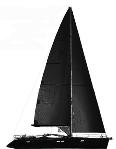
40’ - 48’ - 60’ open slips. Great location in Poulsbo, WA Restrooms, Showers. For More Information
360-779-7762 or 360-509-0178
$500

PAPER CHARTS
Loads of paper charts California to Alaska. Some chart books Mexico, Pacific. Selling all, make offer and you pay shipping or pick up near Jackson Wyoming


» Contact Hugh and Karlene • (307) 690-7876 • Karleneowens@yahoo.com

• $500
Based at Elliott Bay Marina
Please contact us to arrange a visit: 206-285-3632

E-mail: info@emharbor.com

Electronics E-mail: larry@emharbor.com
www.emharbor.com
OPEN AT THE NORTHWEST MARITIME CENTER!
We are hiring for various educator roles to work with youth aged 5 all the way up to adults! Spend your summer season out on the water while providing a fun, inclusive, and safe atmosphere for learning. Positions are based out on our Port Townsend, WA campus. If you're passionate about what we do and eager to learn more, we'd like to meet you!
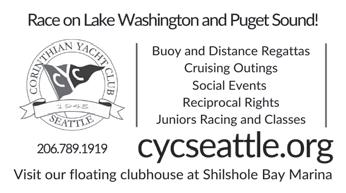
» Full descriptions on our website at nwmaritime.org/about/job-opportunities/



No ocean








Introducing the stunning 2008 Tayana 54 Deck Salon, designed by the renowned naval architect Bill Dixon. This yacht is a true masterpiece, combining exceptional performance and luxurious comfort in one stunning package.
Step aboard and be greeted by a spacious and elegant interior, featuring a raised salon with panoramic views and a beautifully crafted teak and holly sole. The natural light floods the space, creating a warm and inviting atmosphere that is perfect for entertaining or relaxing with family and friends.
The Tayana 54 Deck Salon is a joy to sail, thanks to its superior design and engineering. With a powerful yet easy-to-handle rig, this yacht can handle any weather condition with grace and ease. The spacious cockpit is designed for maximum comfort, with plenty of seating and storage space, perfect for extended cruising.

The 2008 Tayana 54 Deck Salon is the perfect yacht for those who demand the best in luxury, comfort, and performance. This yacht is a true masterpiece, designed and built to the highest standards, and is sure to impress even the most discerning yachtsman. Don’t miss your chance to own this beautiful yacht and experience the ultimate in yachting luxury.

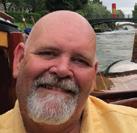




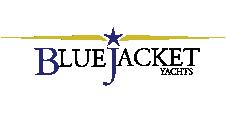

(619) 224-2349 • Fax (619) 224-4692 • 2330 Shelter Island Dr. #207 San Diego, CA 92106 www.yachtfinders.biz • info@yachtfinders.biz


40’ SANTA CRUZ SC40 ’84
..................... $79,000
“KOKOPELLI” An exceptional racer cruiser with many updates and improvements.All lines lead aft. Large dodger. Three year slip possible.

31’ PEARSON 31-2 ’89
..................... $34,500
“SATVA” A fast boat with ample sail area proportioned into a powerful rig. Contemporary hull Almost no wear and tear.
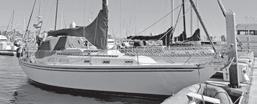
In Monterey
28’ CATALINA 28 MK II ’97
..................... $32,900
“ENSO” Perfect for day sailing, coastal cruising, and family fun. Spacious, comfortable interior. Three year Santa Cruz slip possible
38’
72’ DEERFOOT
72 KETCH ’85
.......... $575,000
“LOCURA” An offshore cruiser easily handled by two. Reverse cycle heating and air for comfort in all climates.
37’
“KNOCKABOUT” Very capable boat. Has been cruised extensively. Blue water gear to carry on in comfort and safety.

31’ HUNTER 31 ’84 $34,500
“ALLURE” Well maintained. Roomy interior. Recent upgrades include new lifelines, BBQ, 32” TV, mainsail and Genoa.
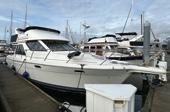

“JUSTINE” Perfect entry level daysailer/ coastal cruiser. Easy to sail. Spacious interior with plenty of headroom.
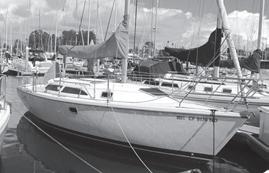
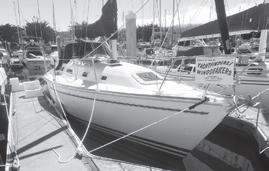


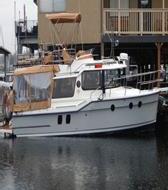
“NIGHT HERON” Superbly customized for offshore single-handed sailing. Same owner has cared for her for 23 years.



THINKING OF SELLING YOUR BOAT? LET US HELP! Power or Sail, we have buyers waiting! Call: 619.224.2349 or email: info@yachtfinders.biz Call our Pacific NW area agent Dan: 360.867.1783







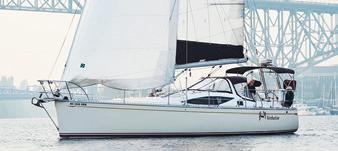
Strong, bare, shallow … The Allures 45.9 is a cruising yacht that combines so many positive features: A strong, easy to maintain aluminum hull with no topsides paint. Three and a half foot draft to access shoal waters. And deceptively good performance with a modern twin rudder, centerboard Olivier Racoupeau design. Gerty is hull No. 3 of this model. The sellers are meticulous, detailoriented sailors who have perfectly balanced cruising comfort with simplicity. They’ve logged numerous 200nm days while crossing the Atlantic. Gerty is ICW capable and located in Rhode Island for summer Northeast cruising or ocean passage to anywhere one desires. – PETE MCGONAGLE,

With brokers on both the west and east coasts, Swiftsure Yachts is dedicated to providing premium service to sailors buying or selling quality yachts.

